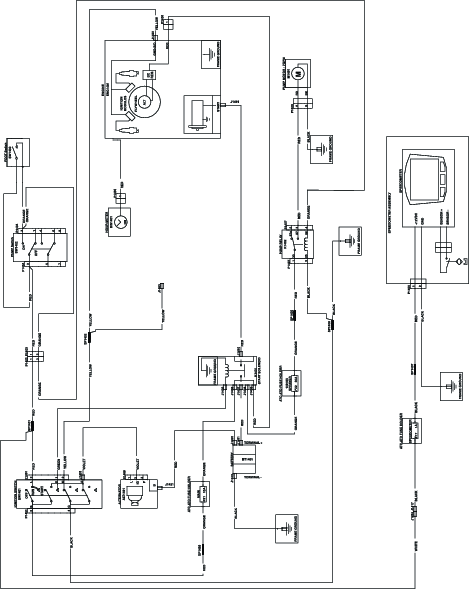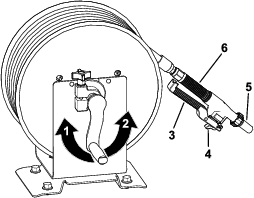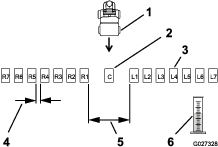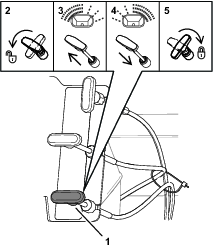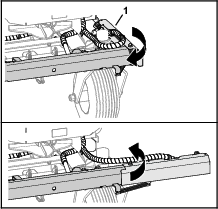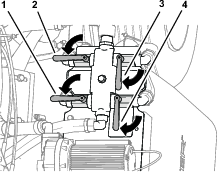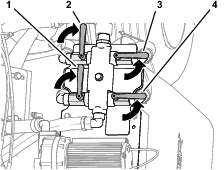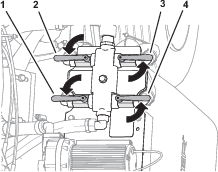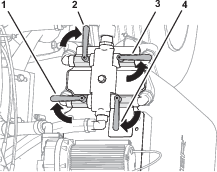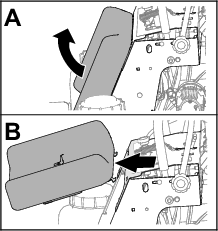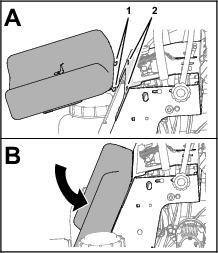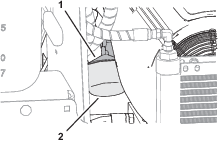| Maintenance Service Interval | Maintenance Procedure |
|---|---|
| After each use |
|
Introduction
This stand-on spreader sprayer is intended for use by trained operators in residential and commercial applications. The machine is primarily designed for chemical distribution used for turf care or snow/ice removal at residential grounds, parks, sports fields, and on commercial grounds. Using this product for purposes other than its intended use could prove dangerous to you and bystanders.
Read this information carefully to learn how to operate and maintain your product properly and to avoid injury and product damage. You are responsible for operating the product properly and safely.
Visit www.Toro.com for product safety and operation training materials, accessory information, help finding a dealer, or to register your product.
Whenever you need service, genuine Toro parts, or additional information, contact an Authorized Service Dealer or Toro Customer Service and have the model and serial numbers of your product ready. Figure 1 identifies the location of the model and serial numbers on the product. Write the numbers in the space provided.
Important: With your mobile device, you can scan the QR code (if equipped) on the serial number plate to access warranty, parts, and other product information.
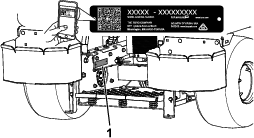
It is a violation of California Public Resource Code Section 4442 or 4443 to use or operate the engine on any forest-covered, brush-covered, or grass-covered land unless the engine is equipped with a spark arrester, as defined in Section 4442, maintained in effective working order or the engine is constructed, equipped, and maintained for the prevention of fire.
The enclosed engine owner's manual is supplied for information regarding the US Environmental Protection Agency (EPA) and the California Emission Control Regulation of emission systems, maintenance, and warranty. Replacements may be ordered through the engine manufacturer.
Warning
CALIFORNIA
Proposition 65 Warning
The engine exhaust from this product contains chemicals known to the State of California to cause cancer, birth defects, or other reproductive harm.
Battery posts, terminals, and related accessories contain lead and lead compounds, chemicals known to the State of California to cause cancer and reproductive harm. Wash hands after handling.
Use of this product may cause exposure to chemicals known to the State of California to cause cancer, birth defects, or other reproductive harm.
Safety
The following instructions are from ANSI standard B71.4-2017.
Safety-Alert Symbol
The safety-alert symbol (Figure 2) is used both in this manual and on the machine to identify important safety messages that you must follow to avoid an accident.
This symbol means Attention! Become Alert! Your Safety Is Involved!

The safety-alert symbol appears above information which alerts you to unsafe actions or situations and is followed by the word Danger, Warning, or Caution.
Danger indicates an imminently hazardous situation which, if not avoided, will result in death or serious injury.
Warning indicates a potentially hazardous situation which, if not avoided, could result in death or serious injury.
Caution indicates a potentially hazardous situation which, if not avoided, may result in minor or moderate injury.
This manual uses 2 other words to highlight information. Important calls attention to special mechanical information and Note emphasizes general information worthy of special attention.
General Safety
This machine is capable of amputating hands and feet and of throwing objects. Toro designed and tested this machine to offer reasonably safe service; however, failure to comply with safety instructions may result in injury or death.
-
Read, understand, and follow all instructions and warnings in the Operator’s Manual and other training materials, on the machine, the engine, and attachments. All operators and mechanics should be trained. If the operator(s) or mechanic(s) cannot read this manual, it is the owner’s responsibility to explain this material to them; other languages may be available on our website.
-
Only allow trained, responsible, and physically capable operators who are familiar with the safe operation, operator controls, and safety signs and instructions to operate the machine. Never allow children or untrained people operate or service the equipment. Local regulations may restrict the age of the operator.
-
Always use appropriate personal protective equipment (PPE) to guard against contact with chemicals.
-
Do not operate the machine near drop-offs, ditches, embankments, water, or other hazards.
-
Do not put your hands or feet near moving components of the machine.
-
Never operate the machine with damaged guards, shields, or covers. Always have safety shields, guards, switches and other devices in place and in proper working condition.
-
Stop the machine, shut off the engine, and remove the key before servicing, fueling, or unclogging the machine.
Safety and Instructional Decals
 |
Safety decals and instructions are easily visible to the operator and are located near any area of potential danger. Replace any decal that is damaged or missing. |


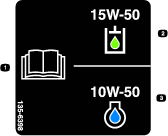
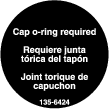
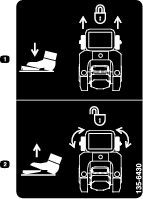



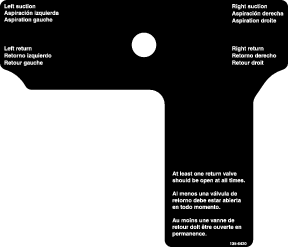
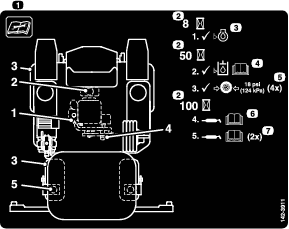
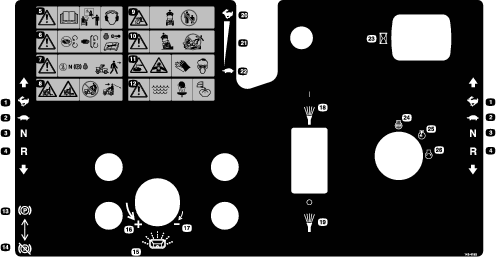

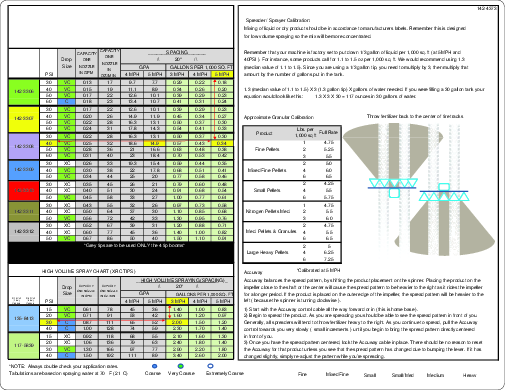
Setup
Checking the Tire Air Pressure
Check the air pressure in the front and rear tires, and if necessary, add air to the appropriate pressure; refer to Checking the Tire Pressure.
Checking the Engine-Oil Level
The engine comes with oil; check the engine-oil level and, if necessary, add to the appropriate level; refer to Checking the Engine-Oil Level and Adding Engine Oil to the Engine.
Checking the Hydraulic-Fluid Level
The hydraulic tank comes with fluid; check hydraulic-fluid level in the hydraulic tank, and if necessary, add to the appropriate level; refer to Checking the Hydraulic Fluid Level.
Connecting the Battery
Install the negative battery cable to the negative (–) battery terminal with a carriage bolt and flanged locknut (Figure 3).
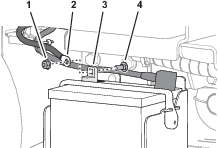
Product Overview
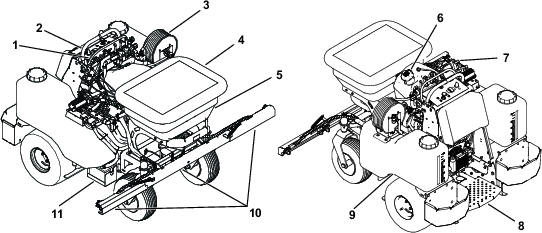
Become familiar with all the controls before you start the engine and operate the machine.
Machine Controls
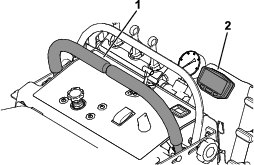
Motion-Control Levers
Use the motion-control levers to drive the machine forward, reverse, and turn either direction (Figure 6).
Display
The sprayer and information display (Figure 6) shows the following information:
-
Ground speed (mph)
-
Time of day
-
Air temperature
-
Battery voltage
Caster-Lock Pedal
Press and hold the caster-lock pedal (Figure 7) to lock the caster wheels in the straight position.
Release the caster-lock pedal to unlock the caster wheels to allow turning.
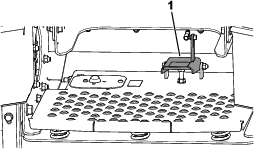
Parking-Brake Lever
-
To engage the parking brake (Figure 8), push the parking-brake lever down.
Note: The brake lever engages a parking brake in the transaxle.
-
To release the parking brake, pull the lever up.
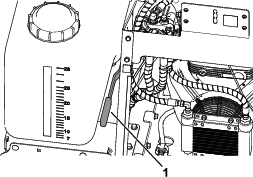
Note: When parking on a steep slope, chock or block the wheels in addition to engaging the parking brake. When transporting the machine, engage the parking brake and bind the machine to the transport vehicle.
Engine Controls
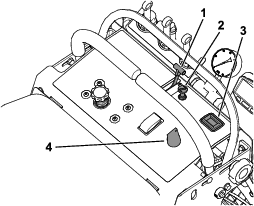
Ignition Switch
The ignition switch is located at the left side of the control console (Figure 9).
Use the ignition switch to start and run, or shut off the engine. The ignition switch has 3 positions: STOP, RUN and START.
Note: You must engage the parking brake to start the engine.
Throttle Control
The throttle controls the engine speed, and it has a continuous-variable setting from the SLOW to FAST position (Figure 9).
Choke Control
Use the choke control to start a cold engine.
Hour Meter
The hour meter displays the total hours of engine operation. The hour meter (Figure 9) starts to function whenever you rotate the key switch to the ON position or if the engine is running.
Spreader Controls
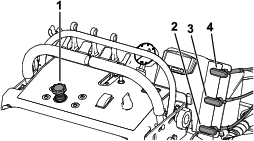
Impeller-Speed Control
Use the impeller-speed control (Figure 10) to set the speed of the hydraulic motor for the spreader.
Hopper-Door Control
The hopper-door control (Figure 10) opens and closes the door inside the base of the hopper
Deflector Control
The deflector control (Figure 10) pivots the deflector into the spreader pattern.
Diffuser Control
The diffuser control (Figure 10) shifts the product placement of the impeller either to the edge of the impeller or to the middle of the impeller.
Drop-Rate Cam and Linkage
The drop-rate cam and linkage are located at the front of the machine and below the hopper on the spreader (Figure 11).
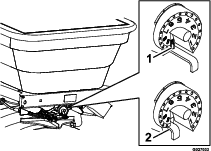
Use the drop-rate cam to set the maximum amount of material to be dispensed through the impeller gate and onto the impeller.
The slot in the cam, after setting 9 on the cam, allows you to open the impeller gate to the maximum position. You can use this setting for dry sand, ice melt, or other materials that are difficult to spread.
Note: Use cam setting 9 when you are cleaning out the hopper.
Sprayer Controls
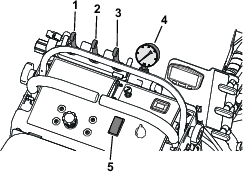
Spray-Pump Switch
Push the spray-pump switch (Figure 12) forward to turn on spray.
Push the spray-pump switch rearward to turn off spray.
Left Boom Spray-Control Valve
Push the left boom sprayer-control valve (Figure 12) to activate spray for the left boom.
Center Boom Spray-Control Valve
Push the center boom sprayer-control valve (Figure 12) to activate spray for the center boom.
Right Boom Spray-Control Valve
Push the right boom sprayer-control valve (Figure 12) to activate spray for the right boom.
Sprayer Pressure Gauge
The sprayer pressure gauge (Figure 12) displays the pressure (in psi) while you are spraying.
Spray-Pump Foot Switch
Press and hold the spray-pump switch (Figure 13) to turn on the spray.
Release the spray-pump switch to shut off the spray.
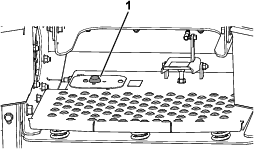
Hose Reel
Spray Wand Trigger
Squeeze the trigger (Figure 14) to the handle to spray; release the trigger to stop.
Spray Wand Trigger Lock
Squeeze the trigger against the handle and push trigger lock (Figure 14) forward to keep the wand in the OPEN position. Pull the lock back to release the trigger.
| Overall width | 46-inch sprayer: 117 cm (46 inches) | |
| 52-inch sprayer: 132 cm (52 inches) | ||
| Overall length | 185 cm (73 inches) | |
| Overall height | 127 cm (50 inches) | |
| Weight | Sprayer tank and hopper empty | 46-inch sprayer: 408 kg (900 lb) |
| 52-inch sprayer (5 GPM): 431 kg (950 lb) | ||
| 52-inch sprayer (7 GPM): 435 kg (960 lb) | ||
| Only hopper full | 46-inch sprayer: 508 kg (1,120 lb) | |
| 52-inch sprayer (5 GPM): 531 kg (1,170 lb) | ||
| 52-inch sprayer (7 GPM): 535 kg (1,180 lb) | ||
| Only sprayer tanks full | 46-inch sprayer: 522 kg (1,150 lb) | |
| 52-inch sprayer (5 GPM): 658 kg (1,450 lb) | ||
| 52-inch sprayer (7 GPM): 662 kg (1,460 lb) | ||
| Sprayer and hopper full with 2 bags of granular | 46-inch sprayer: 667 kg (1,470 lb) | |
| 52-inch sprayer (5 GPM): 803 kg (1,770 lb) | ||
| 52-inch sprayer (7 GPM): 807 kg (1,780 lb) | ||
| Maximum machine weight | Loaded machine + operator | 46-inch sprayer: 771 kg (1,700 lb) |
| 52-inch sprayer (5 GPM): 907 kg (2,000 lb) | ||
| 52-inch sprayer (7 GPM): 912 kg (2,010 lb) | ||
| Hopper capacity | 100 kg (220 lb) | |
| Spreader cast | 0.9 to 7.6 m (3 to 25 ft) | |
| Sprayer tank capacity | 46-inch sprayer: 113.5 L (30 US gallon) | |
| 52-inch sprayer (5 GPM): 227 L (60 US gallon) | ||
| 52-inch sprayer (7 GPM): 227 L (60 US gallon) | ||
| Maximum ground speed | Forward: 12.9 kph (8 mph) | |
| Reverse: 6 kph (4 mph) | ||
Operation
Note: Determine the left and right sides of the machine from the normal operating position.
Before Operation
Performing Daily Maintenance
Before starting the machine each day, perform the following daily-check procedures:
Before Operation Safety
General Safety
-
Evaluate the terrain to determine what accessories and attachments are needed to properly and safely perform the job. Use only accessories and attachments approved by Toro.
-
Inspect the area where you will use the equipment, and remove all rocks, toys, sticks, wires, bones, and other foreign objects that may be contaminated by chemicals and/or affect the stability of the machine.
-
Wear appropriate clothing, including safety glasses, substantial slip-resistant footwear, and hearing protection. Tie back long hair and avoid loose clothing or jewelry that may get tangled in moving parts.
-
Do not operate the machine while people, especially children, or pets are in the area. Stop the machine and the attachment(s) if anyone enters the area.
-
Do not fill, calibrate, or clean the machine while people, especially children, or pets are in the area.
-
Check all sprayer components for wear and leaks before applying pressure to the system. Do not use the machine if it is leaking or damaged.
-
Ensure that the operator platform is clean and free from chemical residue and debris buildup.
-
Check that the operator-presence controls (if applicable), safety switches, and shields are attached and functioning properly. Do not operate the machine unless they are functioning properly. Frequently check for worn or deteriorating components and replace them with the manufacturer’s recommended parts when necessary.
Chemical Safety
Chemical substances used in the spreader-sprayer system may be hazardous and toxic to you, bystanders, animals, plants, soils or other property.
-
Carefully read and follow the chemical warning labels and Safety Data Sheets (SDS) for all chemicals used and protect yourself according to the chemical manufacturer's recommendations. Ensure that as little skin as possible is exposed while using chemicals. Use appropriate personal protective equipment (PPE) to guard against personal contact with chemicals, such as the following:
– safety glasses, goggles, and/or face shield
– chemical-resistant gloves
– rubber boots or other substantial footwear
– hearing protection
– respirator or filter mask
– clean change of clothes, soap, and disposable towels, to be kept on-hand in the event of a chemical spill
-
If you are using more than 1 chemical, read the information about each chemical. Refuse to operate or work on the spreader-sprayer if this information is not available.
-
Before working on a spreader-sprayer system, ensure that the system has been triple rinsed and neutralized according to the recommendations of the chemical manufacturer(s) and that all the valves have been cycled three times.
-
Verify there is an adequate supply of clean water and soap nearby, and immediately wash off any chemicals that contact you.
-
Obtain proper training before using or handling chemicals.
-
Use the correct chemical for the job.
-
Follow the chemical manufacturer's instructions for the safe application of the chemical and do not exceed the recommended system application pressure.
-
Handle chemicals in a well-ventilated area.
-
Have clean water available, especially when filling the spray tank.
-
Do not eat, drink, or smoke while working with chemicals.
-
Do not clean spray nozzles by blowing through them or placing them in your mouth.
-
Always wash your hands and other exposed areas as soon as possible after finishing the work.
-
Keep chemicals in their original packages and in a safe location.
-
Properly dispose of unused chemicals and chemical containers as instructed by the chemical manufacturer and your local codes.
-
Chemicals and fumes are dangerous; never enter the tank or hopper, and do not place your head over or in the opening.
-
Follow all local, state, and federal requirements for spreading and spraying chemicals.
Fuel Safety
Use extreme care when handling fuel.
In certain conditions gasoline is extremely flammable and its vapors are explosive. A fire or explosion from gasoline can burn you, others, and cause property damage.
-
Fill the fuel tank outdoors on level ground, in an open area, when the engine is cold. Wipe up any gasoline that spills.
-
Never refill the fuel tank or drain the machine indoors or inside an enclosed trailer.
-
Do not fill the fuel tank completely full. Fill the fuel tank to the bottom of the filler neck. The empty space in the tank allows the gasoline to expand.
-
Never smoke when handling gasoline, and stay away from an open flame or where gasoline fumes may be ignited by a spark.
-
Store gasoline in an approved container and keep it out of the reach of children.
-
Add fuel before starting the engine. Never remove the cap of the fuel tank or add fuel when engine is running or when the engine is hot.
-
If you spill fuel, do not attempt to start the engine. Move away from the area of the spill and avoid creating any source of ignition until the fuel vapors have dissipated.
-
Do not operate the machine without the entire exhaust system in place and in proper working condition.
-
In certain conditions during fueling, static electricity can be released, causing a spark, which can ignite gasoline vapors. A fire or explosion from gasoline can burn you and others and cause property damage.
-
Always place gasoline containers on the ground away from your vehicle before filling.
-
Do not fill gasoline containers inside a vehicle or on a truck or trailer bed, because interior carpets or plastic truck bed liners may insulate the container and slow the loss of any static charge.
-
When practical, remove gasoline-powered equipment from the truck or trailer and refuel the equipment with its wheels on the ground.
-
If this is not possible, then refuel such equipment on a truck or trailer from a portable container rather than from a gasoline-dispenser nozzle.
-
If you must use a gasoline-dispenser nozzle, keep the nozzle in contact with the rim of the fuel tank or container opening at all times until fueling is complete. Do not use a nozzle lock-open device.
-
-
Gasoline is harmful or fatal if swallowed. Long-term exposure to vapors has caused cancer in laboratory animals. Failure to use caution may cause serious injury or illness.
-
Avoid prolonged breathing of vapors.
-
Keep your face away from the nozzle and gasoline tank or container opening.
-
Keep gasoline away from your eyes and skin.
-
Never siphon gasoline by mouth.
-
-
To help prevent fires, do the following:
-
Keep the engine and the engine area free from accumulation of grass, leaves, excessive grease or oil, and other debris that can accumulate in these areas.
-
Clean up oil and fuel spills and remove fuel-soaked debris.
-
Allow the machine to cool before storing the machine in any enclosure. Do not store the machine near a flame or any enclosed area where open pilot lights or heat appliances are present.
-
Fuel Specification
| Petroleum fuel | Use unleaded gasoline with an octane rating of 87 or higher ((R+M)/2 rating method). |
| Ethanol blended fuel | Use an unleaded-gasoline blend with up to 10% ethanol (gasohol) or 15% MTBE (methyl tertiary butyl ether) by volume is acceptable. Ethanol and MTBE are not the same. |
| Gasoline with 15% ethanol (E15) by volume is not approved for use. Never use gasoline that contains more than 10% ethanol by volume, such as E15 (contains 15% ethanol), E20 (contains 20% ethanol), or E85 (contains up to 85% ethanol). Using unapproved gasoline may cause performance problems and/or engine damage which may not be covered under warranty. |
Important: For best results, use only clean, fresh fuel (less than 30 days old).
-
Do not use gasoline containing methanol.
-
Do not store fuel either in the fuel tank or fuel containers over the winter unless you use a fuel stabilizer.
-
Do not add oil to gasoline.
Using Stabilizer/Conditioner
Use a fuel stabilizer/conditioner in the machine to provide the following benefits:
Important: Do not use fuel additives containing methanol or ethanol.
Add the correct amount of fuel stabilizer/conditioner to the gasoline.
Note: A fuel stabilizer/conditioner is most effective when mixed with fresh gasoline. To minimize the chance of varnish deposits in the fuel system, always use fuel stabilizer.
Filling the Fuel Tank
Fuel tank capacity: 22.7 L (5 US gallons)
-
Park the machine on a level surface and shut off the engine.
-
Allow the engine to cool.
-
Clean around the fuel-tank cap and remove it (Figure 15).
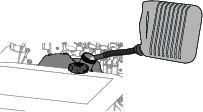
-
Fill the tank with fuel (Figure 15) to the bottom of the filler neck. Do not fill into the filler neck of the tank.
Important: Do not fill the tank more than the bottom of the filler neck because the fuel needs room to expand.
-
Install the fuel-tank cap securely.
-
Wipe up any spilled fuel.
During Operation
During Operation Safety
General Safety
Use your full attention when operating the machine. Do not engage in any activity that causes distractions; otherwise, injury or property damage may occur.
-
Running the engine will cause engine parts, especially the muffler, to become extremely hot. Severe burns can occur on contact, and debris, such as leaves, grass, and brush, can catch fire.
-
Allow engine parts, especially the muffler, to cool before touching them.
-
Remove accumulated debris from the muffler and engine area.
-
-
Engine exhaust contains carbon monoxide, which is an odorless, deadly poison that can kill you. Do not run the engine indoors or in a small, confined area where carbon monoxide fumes can collect.
-
Chemicals are hazardous and can cause personal injury.
-
Read the directions on the chemical labels before handling the chemicals and follow all manufacturer recommendations and precautions.
-
Keep chemicals away from your skin. Should contact occur, wash the affected area thoroughly with soap and clean water.
-
Wear goggles, gloves, and any other protective equipment recommended by the chemical manufacturer.
-
The owner/user can prevent and is responsible for accidents that may cause personal injury or property damage.
-
This machine was designed for 1 operator only. Do not carry passengers and keep all others away from machine during operation.
-
Do not operate the machine under the influence of alcohol or drugs.
-
Operate only in daylight or good artificial light.
-
Do not operate the machine when there is the risk of lightning.
-
Be aware of weather conditions and check that spray nozzles, patterns, and volume are suitable.
-
Keep away from holes, ruts, bumps, rocks, and other hidden hazards. Use care when approaching blind corners, shrubs, trees, tall grass or other objects that may hide obstacles or obscure vision. Uneven terrain could overturn the machine or cause you to lose your balance or footing.
-
Do not operate the machine with damaged guards, shields, or covers. Always have safety shields, guards, switches and other devices in place and working properly.
-
Keep clear of the discharge area at all times.
-
Keep your hands and feet away from moving parts. If possible, Do not make any adjustments while engine is running.
-
-
Your hands, feet, hair, clothing, or accessories can become entangled in rotating parts and cause serious injury.
-
Do not operate the machine without guards, shields, and safety devices in place and working properly.
-
Keep your hands, feet, hair, jewelry, or clothing away from rotating parts.
-
-
Be aware of the spreading/spraying path and direct the discharge away from others. Avoid discharging material against a wall or obstruction as the material may ricochet back toward you.
-
Be alert, slow down, and use caution when making turns. Look behind you and to the side before changing directions. Do not spread or spray in reverse unless it is absolutely necessary.
-
Stop spreading or spraying while making tight turns to minimize uneven distribution pattern, application rate, and chemical drift.
-
Chemicals may drift and cause injury to people and animals; it may also damage plants, soil, or other property.
-
Do not change the engine governor setting or overspeed the engine.
-
Ensure that all drives are in neutral and engage the parking brake before starting the engine.
-
Park the machine on level ground. Shut off the engine, wait for all moving parts to stop, remove key, and engage the parking brake before doing the following:
-
Checking, cleaning, or working on the machine
-
Clearing blockages
-
Leaving the machine; do not leave a running machine unattended.
-
-
Shut off the engine, wait for all moving parts to stop, and engage parking brake before refueling.
-
Tragic accidents can occur if you are not alert to the presence of children. Children are often attracted to the machine and the spreader-spraying activity. Never assume that children will remain where you last saw them.
-
Keep children out of the working area and under the watchful care of another responsible adult.
-
Be alert and shut off the machine if children enter the area.
-
Before and while backing or changing direction, look behind you, down, and side-to-side for small children.
-
Never allow children to operate the machine.
-
Do not carry children, even if the machine is not in use. Children could fall off and be seriously injured or interfere with the safe operation of the machine. Children wanting a ride could appear in the working area without warning and be run over or backed over by the machine.
-
-
Reduce the weight of the load when operating the machine on hills and rough terrain to avoid tipping or overturning of the machine.
-
Liquid loads and granular materials can shift. This shifting happens most often while turning; going up or down hills; suddenly changing speeds; or while driving over rough surfaces. Shifting loads can cause the machine to tip over.
-
When operating with a heavy load, reduce your speed and allow for sufficient stopping distance.
-
Reduce the speed and load while operating the machine on rough terrain, uneven ground, and near curbs, holes, and other sudden changes in terrain. Loads may shift, causing the sprayer to become unstable.
-
Reduce the speed when operating on rough terrain or near curbs.
-
Safely relieve liquid from the spray wand every time you shut off the engine.
-
The spray wand traps liquids under high pressure, even when engine is not running. High-pressure spray discharge could cause serious injury or death.
-
Keep clear of the nozzle and do not direct spray or stream at people, pets, or non-work area property.
-
Do not direct the spray on or near electrical power components or source.
-
Do not repair the spray wand, hoses, seals, nozzle, or other wand components; replace them.
-
Do not attach hoses or other components to the end of the spray wand nozzle.
-
Do not attempt to disconnect the spray wand from the machine while the system is pressurized.
-
Do not use the spray wand if the trigger lock is damaged or missing.
-
Do not keep the spray wand in the locked-open position after you complete the job.
-
When draining or relieving the system, Do not allow anyone to stand in front of the nozzles and do not drain on a person’s feet.
-
Slope Safety
Slopes are a major factor related to loss of control and rollover accidents, which can result in severe injury or death. You are responsible for safe slope operation. Operating the machine on any slope requires extra caution.
-
Review the slope instructions listed below for operating the machine on slopes and to determine whether you can operate the machine in the conditions on that day and at that job site. Changes in the terrain can result in a change in slope operation for the machine.
-
Operate across slopes, never up and down. Avoid operation on excessively steep or wet slopes.
-
Identify hazards at the base of the slope. Determine if the slope is safe for machine operation, including surveying the site. Always use common sense and good judgment when performing this survey.
-
Avoid starting, stopping, or turning the machine on slopes. Travel up and down on slopes. Avoid making sudden changes in speed or direction. If you must turn the machine, turn it slowly and gradually downhill, if possible. Use care when reversing the machine.
-
Do not operate a machine when you are uncertain about the traction, steering, or stability.
-
Remove or mark obstructions such as ditches, holes, ruts, bumps, rocks, or other hidden hazards. Tall grass can hide obstructions. Uneven terrain could overturn the machine.
-
Be aware that operating the machine on wet surfaces, across slopes, or downhill may cause the machine to lose traction. Loss of traction to the wheels may result in sliding and a loss of braking and steering.
-
Use extreme caution when operating the machine near drop-offs, ditches, embankments, water hazards, or other hazards. The machine could suddenly roll over if a wheel goes over the edge or the edge caves in. Establish a safety area between the machine and any hazard.
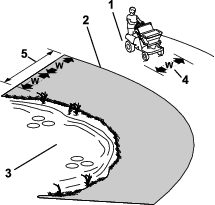
-
Use extra care while operating the machine with attachments; they can affect the stability of the machine.
-
If the engine stalls or you begin to lose momentum while climbing a hill, gradually apply the brakes and slowly back straight down the hill.
-
Always keep the transmission in gear (if applicable) when you drive the machine down a slope.
-
Do not park the machine on an incline.
-
The weight of the material in the tank can change the handling of the machine. To avoid loss of control and personal injury, follow these guidelines:
-
When operating with a heavy load, reduce your speed and allow for sufficient braking distance. Do not suddenly apply the brakes. Use extra caution on slopes.
-
Liquid loads shift, especially while turning, going up or down slopes, suddenly changing speeds, or while driving over rough surfaces. Shifting loads can cause the machine to tip over.
-
Operating the Machine
Starting the Engine
Caution
The machine produces sound levels in excess of 85 dBA at the operator’s ear, and may cause hearing loss through extended periods of exposure.
Wear hearing protection while operating the machine.
-
Move the motion-control levers to the NEUTRAL position and engage the parking brake; refer to Motion-Control Levers and Parking-Brake Lever.
-
Move the throttle lever midway between the SLOW and FAST positions; refer to Throttle Control.
-
If the engine is cold, pull up the choke control to the ON position; refer to Choke Control.
Note: If the engine is warm , push down the choke lever to the OFF position.
-
Rotate the ignition switch to the START position; refer to Ignition Switch.
Note: When the engine starts, release the switch.
Important: Do not crank the engine continuously for more than 10 seconds at a time. If the engine does not start, allow a 60 second cool-down period between starting attempts. Failure to follow these guidelines can overheat the starter motor
-
If the choke control is in the ON position, gradually move the lever down, toward the OFF position as the engine warms up.
Shutting Off the Engine
-
Move motion-control lever to the NEUTRAL position, bring the machine to a full stop, and engage the parking brake; refer to Motion-Control Levers and Parking-Brake Lever.
-
Move the throttle in the midway between the SLOW and FAST positions; refer to Throttle Control.
-
Run the engine for a minimum of 15 seconds, then turn the ignition switch to the OFF position; refer to Ignition Switch.
-
Remove the key; refer to Ignition Switch.
Driving the Machine
Caution
The machine can turn rapidly by moving the steering control to the far right or left. You may lose control of the machine, which may injure you and others, and damage the machine.
-
Use caution when making turns.
-
Slow down the machine before making sharp turns.
Important: If the motion-control levers do not return to the NEUTRAL position when you release them, contact an authorized service dealer.
Important: To begin moving the machine (forward or backward), the parking-brake lever must be released before you move the motion-control lever.
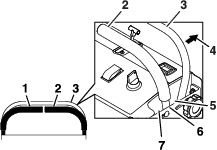
Driving Forward
-
Disengage the parking brake; refer to Parking-Brake Lever.
-
Slowly push the motion-control levers forward (Figure 18).
Note: The farther you move the motion-control levers in either direction, the faster the machine moves in that direction.
Note: To stop, pull the motion-control levers back to the NEUTRAL position.
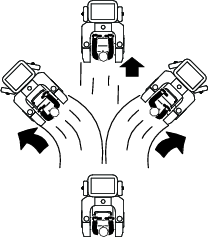
Driving Backward
Slowly pull the motion-control levers rearward (Figure 19).
Note: To stop, pull the motion-control levers back to the NEUTRAL position.

Stopping the Machine
Caution
Children or bystanders may be injured if they move or attempt to operate the machine while it is unattended.
Always remove the key and engage the parking brake when leaving the machine unattended.
-
Move the motion-control levers to neutral and engage the parking brake.
-
If running, shut off the spray pump.
-
If running, shut off the impeller motor.
-
Shut off the engine and remove the key.
-
If you are parking the machine on an incline, chock the tires in addition to engaging the parking brake.
Driving Across Hills
The caster-wheel lock allows the operator to lock the front caster wheels in the forward position to increase side hill stability.
-
Press and hold the caster wheel-lock pedal to lock the caster wheels in the straight position.
-
Release the caster wheel-lock pedal to unlock the caster wheels, and allow the machine to freely turn.
The Display
Refer to the User’s Manual for the display of the following information:
Display Information Types
-
Time of day
-
Stopwatch
-
Ground speed
-
Odometer
-
Battery voltage
-
Hour meter (internal)
-
Air temperature
-
Display battery voltage
Display Operation Controls
-
User interface and buttons
-
Backlighting
-
Data Reset
Setup Mode
-
Units of measure
-
Distance—KM/H (kilometers per hour) or M/H (miles per hour)
-
Temperature—°C or °F
-
-
Clock format and time of day
-
Low voltage caution and warning
Maintenance
Changing the display battery
Operating the Spreader
Caution
Chemicals are hazardous and can cause personal injury.
-
Read the chemical manufacturer’s directions on the label before handling the chemicals; follow all manufacturer recommendations and precautions.
-
Keep chemicals away from your skin. Should contact occur, wash the affected area thoroughly with soap and clean water.
-
Wear eye protection, gloves, and any other protective equipment recommended by the chemical manufacturer.
Use the spreader to disperses free-flowing granular materials such as grass seed, fertilizer, ice melt, etc. When you use the spreader, first fill the hopper, then apply the granular materials to the work site, and finish by cleaning the spreader.
Important: When you use your spreader, thoroughly clean it at the end of the day.
Adjusting the Impeller-Speed Control
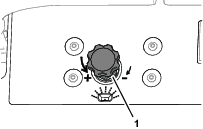
Use the impeller-speed control (Figure 20) to start the hydraulic motor that drives the impeller, adjust the impeller-motor speed and adjust the broadcast pattern width, and shut off the impeller motor.
-
Rotate the impeller control knob counterclockwise to run the impeller motor, increase motor speed and increase the broadcast pattern.
-
Rotate the impeller control knob clockwise to decrease motor speed and decrease the broadcast pattern, or shut off the impeller motor.
Hopper Controls
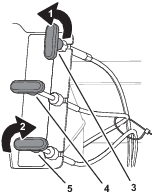
Adjusting the Hopper-Door Control
Important: Close and lock the hopper-door control when you are not spreading.
Use the hopper-door control to open and close granular-substance flow from the hopper.
-
Rotate the handle of the hopper-door control counterclockwise to unlock the control (Figure 21).
-
Open or close the hopper door as follows:
-
Pull the handle to allow granular product to flow from the hopper to the impeller.
-
Push the handle to shut off the flow of granular product.
-
-
Rotate the handle of the hopper-door control clockwise to lock the control (Figure 21).
Adjusting the Deflector Control
Use the deflector control to adjust the broadcast of granular product from left side of the impeller. The deflector control is pulled during normal spreader operation.
-
Rotate the handle of the deflector control counterclockwise to unlock the control (Figure 21).
-
Adjust the broadcast deflector as follows:
-
Pull the handle to broadcast granular product from the left side of the impeller.
-
Push the handle to block granular product from broadcasting at the left side of the impeller.
-
-
Rotate the handle of the deflector control clockwise to lock the control (Figure 21).
Adjusting the Diffuser Control
Use the diffuser control to adjust the spread granular product heavier to the left, consistent in the middle, or heavier to the right.
-
Rotate the handle of the diffuser control counterclockwise to unlock the control (Figure 21).
-
Adjust the diffuser control as follows:
-
Pull the handle to broadcast more granular product from the right side of the impeller.
-
Center the handle to balance the broadcast granular product evenly.
-
Push the handle to broadcast more granular product from the left side of the impeller.
-
-
Rotate the handle of the diffuser control clockwise to lock the control (Figure 21).
Before Operating the Spreader
Before you start using the spreader, calibrate the spreader for the material that you will disperse; refer to Calibrating the Spreader.
Important: Prior to filling the hopper, verify that you have set the proper spreader-application rate.
Calibrating the Spreader
Calibrate the spreader each time you change granular materials. The spreader broadcasts material in a pattern 1 to 7.6 m (3 to 25 ft) wide depending on the material particle size, volume/density, impeller-motor speed, rate of travel, and wind conditions.
Use the Spreading Charts along with information from Determining the Distribution Pattern, Determining the Effective Spreading Width, and Calculating the Application Rate when calibrating the spreader.
Preparing the Test Site and Machine
Operator supplied equipment: 15 shallow collection pans and 15 graduated measuring cylinders
Note: The most accurate method to measure the distribution uses shallow collection pans and graduated measuring cylinders. In the example below, the 15 shallow collection pans approximately 30 cm (12 inches) wide, 91 cm (36 inches) long, and 5 cm (2 inches) tall.
-
Place one pan in the center of the drive path. Arrange the next two pans, one on each side, far enough apart to allow adequate room for the drive tires of the machine to pass around the center pan.
-
Place the remaining pans in a straight line as shown in Figure 22 or Figure 23.
-
Move the machine far enough away from the test area (where the collection pans are located) to ensure that the machine travels at the desired spreading speed before reaching the site.
-
Determine the application rate and the related drop-rate cam setting; refer to Spreading Charts.
-
Rotate the drop rate cam (Figure 24) to the cam setting you determined in step 4.
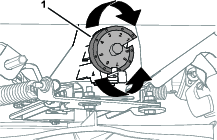
-
Ensure that the hopper-door control is in the close position, and fill the hopper approximately half-full with the desired material; refer to Hopper Controls.
-
Pull the deflector control handle and lock it; refer to Adjusting the Deflector Control.
Determining the Distribution Pattern
-
Set the diffuser control to the middle of its travel and lock it; refer to Adjusting the Diffuser Control.
-
Adjust the impeller speed control to set the broadcast pattern width; refer to Adjusting the Impeller-Speed Control.
-
Drive the machine toward the test site at the appropriate speed.
-
As you approach the center pan, pull the wide distribution granular gate control to the open position, and drive over the center pan.
-
Close the gate control, move motion-control lever to the NEUTRAL position, shut off the engine, wait for all moving parts to stop, remove key, and engage parking brake.
-
Label each graduated measuring cylinder to correspond with the distribution pans (such as L2, L1, Center, R1, R2); refer to Figure 22 and Figure 23.
-
One at a time, take a collection pan and dump the contents into the corresponding graduated cylinder. Record the amount of granular material collected and return the pan to its location. Repeat this until all pan contents have been emptied.
Note: Repeat broadcasting over the test site several times, moving in the same direction each time, until enough material is dispensed to the collection pan to half fill a graduated cylinder.
-
With the graduated measuring cylinder in the same straight line as the pans, evaluate the volume of material in each cylinder to determine the quality of the distribution from the spreader.
-
To adjust the spreader pattern, refer to the Adjusting the Spreader Pattern.
-
Fill the hopper half-full of the desired material and repeat steps 1 through 9 until you achieve a uniform pattern.
Determining the Effective Spreading Width
Use the effective width to determine the uniform distribution of the granular material.
Note: The spreading width range is 1 to 8 m (3 to 25 ft).
-
After the spreader pattern is correctly adjusted, evaluate the amount of material in the center graduated measuring cylinder.
-
Locate the 2 graduated cylinder, one each side of center, that contains 1/2 the measured amount of the material that you observed in the center graduated cylinder.
-
Go to the two corresponding pans. Starting from the outer edge, measure the distance between left pan, across the center pan, to the outer edge of the right pan, and record the measurement.
Record the effective spreading width here: .
Preparing the Calibration Course for Calculating the Application Rate
-
Determine a course length by dividing 93 m2 (1,000 ft2) by the effective spread width that you determined in Determining the Effective Spreading Width; use the course length formula. Record the course length here: .
Calibration Course Length Formula
Formula 93 m2 (1,000 ft2) / Effective width measurement = Calibration course length Example 93 m2 (1,000 ft2) / 1.8 m (6 ft) = 51 m (167 ft) Note: In this example the effective width measures 1.8 m (6 ft).
-
Measure and visibly mark the course length. Ensure that you allow enough distance before the starting marker so that the spreader moving forward at full speed when crossing the first mark of the course.
Calculating the Application Rate
-
Determine the area and amount of material that you are applying to the job site and record those amounts in the area and materials worksheet.
Record the job site area here: .
Record the amount of job site material here: .
-
Initially, use the recommended application rate indicated in theSpreading Charts section or use the rate recommended listed on the product manufacturer’s label as a guide to help determine the amount of material that you would spread over a 93 m2 (1,000 ft2) area.
Note: In this example the calibration course is 1.8 m (6 ft) by 51m (167 ft).
-
Set the appropriate drop-rate cam setting; refer to the Spreading Charts as a starting point.
-
Add material to the hopper.
Note: In this example we added 11.3 kg (25 lb) of material.
-
Drive the spreader over the calibration course while applying the material.
-
Empty the remaining material of the hopper into a clean bucket.
-
Weigh the bucket containing the material and record the weight. Pour the contents back into the hopper and then weigh the empty bucket. Calculate the remaining material weight using the remaining material weight formula. Record the remaining material weight here: .
Remaining Material Weight Formula
Formula (Remaining material and bucket weight) - (Bucket weight) = Remaining material weight Example 10 kg (22 lb) - 1 kg (2 lb) = 9 kg (20 lb) Note: In this example, 9 kg (20 lb) of material remain in the hopper after applying the material to the test course.
-
Calculate applies material weigh using the applied material formula that follows. Record the applied material weight here: .
Applied Material Weight Formula
Formula (Original material weight) - (Remaining material weight) = Applied material weight Example 11.3 kg (25 lb) - 9 kg (20 lb) = 2.3 kg (5 lb) 3 Note: This calculation means that at the selected motor-rotation speed, 2.3 kg (5 lb) of material was applied to the 93 m2 (1,000 ft2) test course.
-
If necessary, adjust the drop-rate cam to achieve the recommended application rate. Once you achieve the correct application rate, repeat this procedure an additional time to verify your results.
Important: Designate a new calibration course each time, so that the turf is not damaged by excessive application of material.
Filling the Spreader Hopper
Maximum hopper weight capacity: 100 kg (220 lb)
-
Drive the machine to the work site.
-
Move the machine to a level surface, move motion-control lever to the NEUTRAL position, shut off the engine, wait for all moving parts to stop, remove key, and engage parking brake.
-
Ensure that the hopper-door control is in the fully forward (closed) position; refer to Adjusting the Hopper-Door Control.
-
Use the Spreading Charts to determine the setting for the drop-rate cam (Figure 25).
Note: If the setting is not listed for the type of material that you are using, set the cam to the setting with a lower value then adjust as needed.
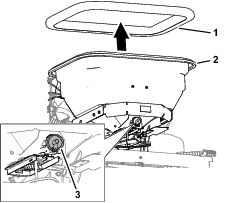
-
Remove the cover from the hopper, add the material that you are spreading, and install the cover onto the hopper (Figure 25).
Note: Do not overload the hopper; the maximum weight capacity of the hopper is 100 kg (220 lb).
Note: You may place extra bags of granular material in the cargo boxes behind the spray tanks.
Using the Spreader
Spreading Charts
Note: The cam setting tables for granular material and the grass seed are provided with permission from the Brinly-Hardy Company; reference the Brinly-Hardy Company website for more information.
Use these charts as an approximate guideline only. Other factors, such as weather conditions, spreader operation, and the condition of material affects spreader performance.
| Type | kg per 93 m2 (lb per 1,000 ft2) | Cam Setting — One Pass | Cam Setting — Two Passes |
| Fine Pellets | 0.5 (1) | 3.6 | 3.1 |
| 0.9 (2) | 4.0 | 3.5 | |
| 1.4 (3) | 4.2 | 3.7 | |
| Mixed Fine Pellets | 0.9 (2) | 3.7 | 3.2 |
| 1.8 (4) | 4.7 | 4.1 | |
| 2.7 (6) | 5.2 | 4.5 | |
| Small Pellets | 0.9 (2) | 3 | 2.2 |
| 1.8 (4) | 4.2 | 3.7 | |
| 2.7 (6) | 4.5 | 4 | |
| Nitrogen Pellets Medium Size | 0.5 (1) | 3.5 | 3 |
| 0.9 (2) | 4.2 | 3.7 | |
| 1.4 (3) | 4.7 | 4 | |
| Medium Pellets and Granules | 0.9 (2) | 3.5 | 3 |
| 1.8 (4) | 4.2 | 3.8 | |
| 2.7 (6) | 5.2 | 4.5 | |
| Large Heavy Pellets | 0.9 (2) | 3.8 | 3.3 |
| 1.8 (4) | 4.9 | 4.1 | |
| 2.7 (6) | 5.9 | 4.9 |
Use the chart below for reference only. When spraying and spreading at the same time, set the spread pattern to twice the width of the spray; this will help avoid striping and streaking. For example, standard spray width = 2.7 m (9 ft) and spread width = 5.4 m (18 ft).
| Type | Bag Weight | Coverage - m2 (ft2) | Cam Setting – Full Rate | Cam Setting – Half Rate | Spreader Width |
|---|---|---|---|---|---|
| Blue Grass or Red Top | 0.23 kg (0.5 lb) | 93 (1,000) | 1.25 | 4 | |
| 0.45 kg (1 lb) | 93 (1,000) | 2.0 | 4 | ||
| 0.9 kg (2 lb) | 93 (1,000) | 2.5 | 4 | ||
| Park, Merion, Delta, or Kentucky Bluegrass | 2.27 kg (.5 lb) | 93 (1,000) | 2.5 | 4 | |
| 0.45 kg (1 lb) | 93 (1,000) | 3.0 | 4 | ||
| 0.9 kg (2 lb) | 93 (1,000) | 3.5 | 4 | ||
| Hulled Bermuda | 0.9 kg (2 lb) | 93 (1,000) | 2.75 | 2.25 | 6 |
| 1.36 kg (3 lb) | 93 (1,000) | 3.0 | 2.5 | 6 | |
| 1.81 kg (4 lb) | 93 (1,000) | 3.25 | 2.75 | 6 | |
| Mixtures Including Coarse Seeds | 0.9 kg (2 lb) | 93 (1,000) | 6.0 | 6 | |
| 1.81 kg (4 lb) | 93 (1,000) | 7.0 | 6 | ||
| 2.72 kg (6 lb) | 93 (1,000) | 7.0 | 6 | ||
| Rye Grasses or Tall Fescue | 0.9 kg (2 lb) | 93 (1,000) | 6.0 | 6 | |
| 1.81 kg (4 lb) | 93 (1,000) | 7.0 | 6 | ||
| 2.72 kg (6 lb) | 93 (1,000) | 7.75 | 6 | ||
| Dichondra | 113 kg (4 oz) | 93 (1,000) | 1.9 | 8 | |
| 227 g (8 oz) | 93 (1,000) | 2.1 | 8 | ||
| 340 g (12 oz) | 93 (1,000) | 2.5 | 8 | ||
| Pensacola Bahia | 1.81 kg (4 lb) | 93 (1,000) | 4.5 | 3.75 | 7 |
| 2.27 kg (.5 lb) | 93 (1,000) | 4.75 | 4.0 | 7 | |
| 2.72 kg (6 lb) | 93 (1,000) | 5.0 | 4.25 | 7 |
Adjusting the Spreader Pattern
If the spreader casts material unequally side-to side—too light/heavy to one side—(see Figure 26, adjust the spreader-pattern.
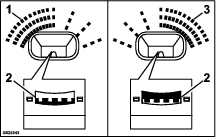
Note: Do not adjust the ramps that split the product flow. Adjust only the front or rear ramp positions.
Using the Deflector Gate
Use the deflector control to temporarily stop or deflect granular material away from sidewalks, parking lots, patios, or anywhere the granular chemicals are not desired.
Note: The deflector gate changes the discharged of materials from the left side of the spreader only.
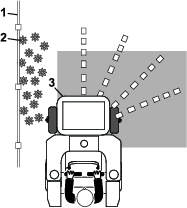
-
Pull the deflector-control handle to broadcast granular product from the left side of the impeller.
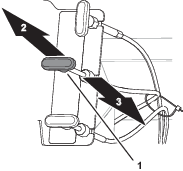
-
Push the handle to temporarily block granular product from broadcasting at the left side of the impeller.
Spreading Granular Material
-
Start the engine, and adjust the throttle midway between the SLOW and the FAST positions.
-
Rotate the knob of the impeller-speed control to run the impeller motor (Figure 30).

-
Move the throttle to the FAST position, and drive the machine forward.
-
Open the hopper-door control to begin spreading the granular material (Figure 31).
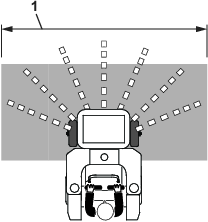
-
Evaluate the spread pattern.
Note: If you need to adjustment the spreading pattern, refer to Adjusting the Impeller-Speed Control, Calibrating the Spreader, and Adjusting the Spreader Pattern.
-
When you are finished spreading, close the hopper-door control.
-
Clean the hopper after each spreading session; refer to Cleaning and Lubricating the Spreader.
Important: Always empty and clean the spreader immediately after each use. Failure to do so may cause the chemicals to corrode the spreader and other components.
Spreading Tips
Important: Ensure that you calibrate the spreader before you start using it.
-
To ensure uniform application, broadcast pellet or granular material in an overlapping pattern.
Note: The highest amount of material will dispense from the front of the hopper and less material from each side. You can adjust the distribution pattern to achieve the desired results.
-
Watch for changes in the distribution pattern; unequal distribution may lead to striping.
Operating the Sprayer
Caution
Chemicals are hazardous and can cause personal injury.
-
Read the chemical manufacturer’s directions on the label before handling the chemicals; follow all manufacturer recommendations and precautions.
-
Keep chemicals away from your skin. Should contact occur, wash the affected area thoroughly with soap and clean water.
-
Wear eye protection, gloves, and any other protective equipment recommended by the chemical manufacturer.
Use the sprayer to disperse liquid herbicides, pesticides, fertilizers, and other substances. Before using the sprayer ensure that you have cleaned the tank, plumbing, and nozzles before adding any chemicals. When you use the sprayer, you first fill the spray tank, then apply the chemical solution to the work site, and then when you are finished spraying, clean the tank. It is important to complete all 3 of these steps to avoid damaging the sprayer. For example, Do not mix and add chemicals in the spray tank the night before and then spray in the morning. This could lead to separation of the chemicals and possible cause damage to components of the sprayer.
Important: When you use your sprayer, thoroughly clean it at the end of the day.
Extending and Folding the Outer Spray Booms
Using the Sprayer Tank Shutoff Valves
Transferring Fluid Between Tanks
Transferring Fluid from the Left Tank to the Right Tank
-
Ensure that the right tank has capacity to hold fluid from the left tank.
-
Ensure that the handles for the spray-control valves are in the OFF position (Figure 36).
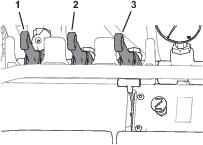
-
Loosen the locknut, and open the throttle valve (Figure 37).
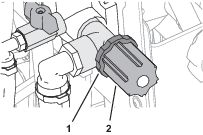
-
Rotate the valve handles as shown in Figure 38.
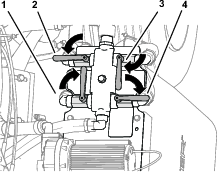
-
Press the sprayer-pump switch to the ON position (Figure 39).

-
When the quantity of fluid is transferred to the right tank, press the sprayer-pump switch to the OFF position.
Transferring Fluid from the Right Tank to the Left Tank
Sprayer Nozzle Application Rate
The machine is factory equipped with lavender colored nozzle tips that have an application rate of 1.3 L (0.34 US gallon) per 93 m2 (1,000 ft2) when the sprayer pressure is 2.8 bar (40 psi), and the machine is driven 8 kph (5 mph).
-
Use to the nozzle application rate chart that follows when selecting nozzles and spraying with the machine.
-
Refer to the spreader/sprayer chart affixed to the back of the knee pad for quick reference calibration information in the field.
-
Your machine supports application rates between 0.95 L per 93 m2 (0.25 US gallon per 1,000 ft2) through 3.8 L per 93 m2 (1.0 US gallon per 1,000 ft2).
Note: Each sprayer tip shuts off when sprayer pressure is <0.3 bar (5 psi) to prevent dripping.
| Nozzle tip color | Ground speed | Sprayer pressure | Application rate | |||
|---|---|---|---|---|---|---|
| Yellow | 8 kph | 5 mph | 2.8 bar | 40 psi | 1.0 L/ 93 m2 | 0.27 (1/4) US gallon/ 1,000 ft2 |
| Lavender | 8 kph | 5 mph | 2.8 bar | 40 psi | 1.3 L/ 93 m2 | 0.34 (1/3) US gallon/ 1,000 ft2 |
| Red | 8 kph | 5 mph | 2.8 bar | 40 psi | 2.0 L/ 93 m2 | 0.54 (1/2) US gallon/ 1,000 ft2 |
| Brown | 8 kph | 5 mph | 3.4 bar | 50 psi | 2.9 L/ 93 m2 | 76 (3/4) US gallon/ 1,000 ft2 |
| Gray | 6.5 kph | 4 mph | 2.8 bar | 40 psi | 3.8 L/ 93 m2 | 1 US gallon/ 1,000 ft2 |
Important: Note: this chart only applies if you use air injected nozzle tips. Using other tips require different calculations
Adjusting the Sprayer Pressure
The throttle valve adjusts sprayer pressure. The throttle valve is located at the left side of the control console.
-
Turn the knob of the throttle valve clockwise to increase spray-system pressure (Figure 42).

-
Turn the knob of the throttle valve counterclockwise to decrease spray-system pressure (Figure 42).
Sprayer-system pressure displays on the pressure gauge (Figure 43). When the spray nozzles are open, sprayer-system pressure decreases slightly; adjust throttle valve to compensate for the drop in pressure.

Mixing Product
Calculating the Average Application Rate
To determine about of product to mix for solution of chemical in the tank, you need to understand what nozzle application rate of your machine (the factory installed lavender nozzle tip application rate is 1.3 L/93 m2 (1 / 3 gallon per 1,000 ft2).
For example, a product may specify an application rate range of 33 to 44 ml/93 m2 (1.1 to 1.5 oz per 1,000 ft2). When calibrating the sprayer, use the formula that follows to calculate the average application rate:
| [lowest application rate] + [highest application rate] | = [sum rate] |
| [sum rate] / 2 | = average application rate |
Example: 33 + 44 ml (1.1 + 1.5 oz) = [77 ml (2.6 oz) sum rate]; 77 ml / 2 (2.6 oz / 2) =38.5 ml/93 m2 (1.3 oz per 1,000 ft2)―the average application rate value
Calculating the Amount of Product for a Solution of Chemical
-
Multiply the average product application rate by the 1-gallon nozzle tip factor to determine the 1-gallon application rate.
Example: median application rate value—38 ml/93 m2 (1.3 fl oz per 1,000 ft2) of 1.1 to 1.5) x 3 (lavender nozzle tip—nozzle tip factor) = 3.9 (adjusted application rate)
-
Multiply the 1-gallon application rate by the amount of chemical solution that you need to add to the spray tank.
Example: 3.9 (adjusted application rate) x gallons needed. If you are preparing a 114 L (30 US gallon) solution of chemical, use 3.5 L (117 fl oz) of product (3.9 x 30) for 114 L (30 US gallon) of water.
| Average product application rate (example) | Nozzle tip/ application rate | Nozzle tip factor | Water in the sprayer tank (example) | Product per 114 L (30 US gallon) (example) |
|---|---|---|---|---|
| 38 ml/93 m2 (1.3 fl oz per 1,000 ft2) | Yellow 1.0 L/93 m2 (0.27 or 1/4 US gallon/ 1,000 ft2) | (x) 4 | (x) 114 L (30 US gallons) | 4.6 L (156 fl oz) |
| 38 ml/93 m2 (1.3 fl oz per 1,000 ft2) | Lavender 1.3 L/93 m2 (0.34 or 1/3 US gallon/ 1,000 ft2) | (x) 3 | (x) 114 L (30 US gallons) | 3.5 L (117 fl oz) |
| 38 ml/93 m2 (1.3 fl oz per 1,000 ft2) | Red 2.0 L/93 m2 (0.54 or 1/2 US gallon/ 1,000 ft2) | (x) 2 | (x) 114 L (30 US gallons) | 2.3 L (78 fl oz) |
| 38 ml/93 m2 (1.3 fl oz per 1,000 ft2) | Brown 2.9 L/93 m2 (.76 (3/4) US gallon/ 1,000 ft2) | (x) 1.3 | x 114 L (30 US gallons) | 1.5 L (51 fl oz) |
| 38 ml/93 m2 (1.3 fl oz per 1,000 ft2) | Gray 3.8 L/93 m2 (1 US gallon/ 1,000 ft2) | (x) 1 | (x) 114 L (30 US gallons) | 1.2 L (39 fl oz) |
Using the Sprayer
Before Operating the Sprayer
Some chemicals are more aggressive than others and each chemical interacts differently with various materials. Some consistencies of sprayer chemicals (e.g. wettable powders, charcoal) are more abrasive and lead to higher-wear rates. If a chemical is available in a formulation that would provide increased life to the sprayer, use this alternative formulation.
Calibrate the sprayer before you start the spray application; refer to Sprayer Nozzle Application Rate.
Filling the Tank
Important: Ensure that the chemicals that you are using in the sprayer are compatible for use with O-rings and seals made from fluoroelastomer material (refer to the chemical manufacturer's label; it should indicate if it is not compatible). If you use a chemical that is not compatible with fluoroelastomer material, the O-rings and seals in the sprayer can degrade and leak.
Important: Do not use brackish or reclaimed water in the spray system.
-
Move the machine to a level surface, move motion-control lever to the NEUTRAL position, shut off the engine, wait for all moving parts to stop, remove key, and engage parking brake.
-
Ensure that the 3 boom sprayer-control valves are in the OFF position.
-
Adjust the tank shutoff valves for the spray tank that you are using; refer to Using the Sprayer Tank Shutoff Valves.
-
Determine the amount of product and water needed to mix the amount of chemical solution as specified by the chemical manufacturer; refer to Calculating the Amount of Product for a Solution of Chemical.
-
Open the tank cap on the spray tank (Figure 44).
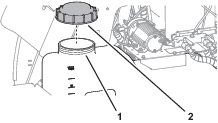
-
Add 3/4 of the required water to the sprayer tank through the filler neck.
Important: Always use fresh, clean water in the spray tank. Do not pour chemical concentrate into an empty tank.
-
Loosen the locknut and turn the knob of the throttle valve counterclockwise (Figure 42).
-
Start the engine and set the throttle midway between the SLOW and FAST positions.
-
Set the sprayer-pump switch to the ON position (Figure 45).

-
Move the throttle to the FAST position.
Note: The water in the tank will circulate.
-
Add the specified amount of chemical concentrate to the tank as directed by the chemical manufacturer.
Important: If you are using a wettable-powder chemical, mix the powder with a small amount of water to form a liquid slurry before adding the chemical mixture to the tank.
-
Add remaining water to the tank and install cap onto the filler neck of the tank.
Note: Allow the content of the sprayer tank to mix thoroughly.
Important: Before applying chemicals to the job site, adjust the sprayer-pressure with the throttle valve according to the sprayer nozzle application rate.
Spraying with the Sprayer Boom
Important: To ensure that your chemical solution remains well mixed. For the agitation feature to work, set the sprayer-pump switch to the ON position, pull back the tank-agitation lever, and run the engine at high idle. If you shut off the machine and agitation is needed, leave the motion-control lever in the NEUTRAL position, engage the parking brake, increase the throttle to the FAST position, start the sprayer pump and run tank agitation.
Note: Calibrate the sprayer before you start the spray application; refer to Sprayer Nozzle Application Rate.
-
Press the spray-pump switch on the control console to the OFF position.
-
Adjust the sprayer-pressure with the throttle valve according to the sprayer nozzle application rate; refer to Adjusting the Sprayer Pressure.
-
Drive the machine to the job site.
-
As needed, set the left, center, and right boom sprayer-control valves to the ON position.
-
Drive the machine and step on the spray-pump foot switch to turn on the spray pump; refer toSpray-Pump Foot Switch.
Important: Keep your hands on the traction control levers; use the spray-pump foot switch. Use the spray-pump switch on the control console for mixing the tank(s), transferring fluid between tanks, and spraying with the hand wand.
Note: Step off the spray-pump foot switch to shut off spray pump.
-
When you finish spraying, move the boom sprayer-control valves are in the OFF position.
Note: If you need to continue to mix the sprayer tank contents, open the throttle valve, and use the spray-pump switch on the control console.
Spraying Tips
-
Do not overlap the effective spray area that you have previously sprayed (Figure 46).
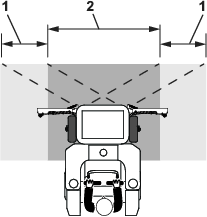
-
Watch for plugged sprayer nozzles.
-
Move the boom sprayer-control valves to the OFF position to stop the spray flow before stopping the motion of the machine. Once stopped, leave the motion-control lever in NEUTRAL and leave the sprayer-pump switch in the ON position.
-
You obtain better results if the machine is moving when spray controls are turned ON.
-
Ensure adequate pump pressure for proper spray distribution by push the tank-agitation lever to the OFF position.
-
Watch for changes in the application rate. Changes in the application rate indicate that your ground speed has changed beyond the operating range of the nozzles or there is a problem with the sprayer system.
Note: When the tank is nearly empty, the tank agitation may cause foaming of the chemical solution in the tank. In this case, throttle valve to the OFF position. Alternatively, if an anti-foaming agent compatible with the existing chemical—add the anti-foaming agent according to the manufacturer’s instructions.
Spraying with the Spray Wand
Warning
The spray wand traps liquids under high pressure, even when engine is off. High-pressure spray discharge could cause serious injury or death.
-
Keep clear of the nozzle and do not direct the spray or stream from the wand at people, pets, or non-work area property.
-
Do not direct the spray at or near electrical-power components or source.
-
Do not repair the spray wand, hoses, seals, nozzle, or other wand components; always replace them.
-
Do not attach the hoses or other components to the nozzle at the end of the spray wand.
-
Do not attempt to disconnect the spray wand from the machine while the sprayer system is pressurized.
-
Do not use the spray wand if trigger lock is damaged or missing.
-
Rotate the spray-wand lock to the OFF position when job is complete.
-
Move the machine to a level surface, move motion-control lever to the NEUTRAL position, and engage parking brake.
-
Ensure that the 3 boom sprayer-control valves are in the OFF position.
-
Remove the spray wand from the tool clip at the left side of the machine (Figure 47).

-
Firmly grip the spray wand and point it in the direction that you will spray.
Note: The wand may recoil; ensure that you hold it securely.
-
Open spray wand-shutoff valve (Figure 47).
-
Use the throttle valve (Figure 47) to adjust the spray-system pressure as follows:
-
To increase the spray-system pressure to the wand, rotate the throttle valve clockwise.
-
To decrease the spray-system pressure to the wand, rotate the throttle valve counterclockwise.
-
-
Squeeze the trigger to the spray-wand handle to begin spraying; lock the trigger in place if desired (Figure 48).
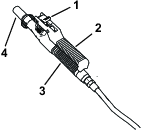
-
When finished spraying, if you locked the trigger of the spray-wand—unlock it, and release the trigger (Figure 48)
-
Close the spray wand-shutoff valve, shut off the spray pump, and insert the spay wand into the tool clip (Figure 47).
After Operation
After Operation Safety
General Safety
-
Park the machine on level ground and allow it to cool. Never allow untrained personnel to service the machine.
-
Disengage the spray or close the spreader gate, set the parking brake, shut off the engine, and remove the key or disconnect the spark-plug wire. Wait for all movement to stop before adjusting, cleaning or repairing the machine.
-
Clean the machine as stated in Cleaning the Spreader and Cleaning the Sprayer
-
Frequently check for worn or deteriorating components that could create a hazard. Tighten loose hardware.
-
Shut off the fuel when storing or transporting the machine. Do not store fuel near flames or drain fuel indoors.
Cleaning and Lubricating the Spreader
Cleaning the Spreader
Important: Do not use brackish or reclaimed water to clean the machine.
-
Drive the machine to a designated cleaning area with a level surface.
-
Move the motion-control levers to the NEUTRAL position, shut off the engine, wait for all moving parts to stop, remove key, and engage parking brake.
-
If installed, remove the cover, and empty the hopper.
-
Open the hopper gate to the maximum open position:
-
Pull rate gate linkage outward (Figure 49).
-
Rotate the drop rate cam until the slot aligns with the linkage (Figure 49).
-
Push in the linkage (Figure 49).

-
-
Rotate the 2 hopper screens and remove them from the hopper pan (Figure 50).

-
Remove any pellet or granular material at the bottom of the hopper.
-
Using a hose to spray the inside and outside of the entire spreader with clean water.
Note: Do not use a power washer to clean the machine. The high-pressure water can force residual-corrosive materials into sprayer-spreader components.
-
Install the hopper screens.
-
Allow the hopper to drained, pull the linkage, and adjust the drop-rate cam to position 9.
Lubricating the Spreader
-
Apply water-displacing lubricant to the control cables and pivot points as shown in Figure 51.
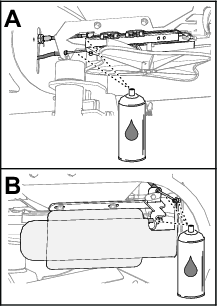
-
Allow the spreader-sprayer to completely dry before the next use.
Cleaning the Sprayer
| Maintenance Service Interval | Maintenance Procedure |
|---|---|
| After each use |
|
Warning
Swallowing or inhaling chemicals could cause serious injury or death.
-
Do not clean sprayer nozzles using your mouth or blowing through the nozzles.
-
Replace all worn and damaged sprayer nozzles.
-
Ensure that the nozzles are installed correctly.
Important: Do not use brackish or reclaimed water to clean the machine.
Preparing the Machine
-
Empty the sprayer tank.
-
Fill the sprayer tank with 19 L (5 US gallons) or more of clean water and install the cap; refer to Filling the Tank.
-
Engage the parking brake, move the motion-control levers to the NEUTRAL position, and start the engine.
-
Set the engine throttle to FAST position.
Cleaning the Sprayer System and Wand
Important: Always empty and clean the sprayer immediately after each use. Failure to do so may cause the chemicals to dry or thicken in the hoses, clogging the pump and other components.
-
Adjust the sprayer-pressure with the throttle valve; refer to Adjusting the Sprayer Pressure.
-
Set the left, center, and right boom sprayer-control valves to the ON position.
-
On the control console, press the spray-pump switch to turn on the spray pump; refer to Spray-Pump Switch.
-
Allow the rinse water in the tank to spray through the nozzles.
-
Check that all nozzles spray correctly.
-
Remove the sprayer wand from the holder, point the wand in a safe direction, and squeeze the trigger; refer to Spraying with the Spray Wand.
Note: Allow the rinse water to discharge from the wand for 1 to 2 minutes.
-
Release the trigger for the wand and return it to the tool clip on the machine; refer to Spraying with the Spray Wand.
-
Move the boom sprayer-control valves to the OFF position, set the sprayer-pump switch to the OFF position, and shut off the engine.
-
Clean the strainer; refer to Cleaning the Strainer.
-
Repeat steps 2 through 9 using cleaners and neutralizers recommended by the chemical manufacturers; refer to Filling the Tank.
-
Repeat steps 2 through 9 using clean water only.
Cleaning the External Components
-
Using a hose to wash off the outside of the sprayer tank with clean water.
Note: Do not use a power washer to clean the machine. The high-pressure water may force residual corrosive materials into spreader-spreader components.
-
Remove and clean the sprayer nozzles; refer to Cleaning the Sprayer System and Wand.
Note: Replace damaged or worn nozzles.
-
Allow the spreader-sprayer to completely dry before the next use.
Cleaning the Strainer
| Maintenance Service Interval | Maintenance Procedure |
|---|---|
| After each use |
|
Important: If you used wettable-powder chemicals, clean the strainer after each time that you rinse the sprayer tank.
-
Rotate the left tank and right tank return and suction valves to the closed position (Figure 52).
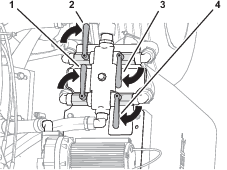
-
Align a drain pan under the strainer (Figure 53).

-
Rotate the strainer bowl counterclockwise and remove the bowl and screen from the body of the strainer (Figure 54).
Note: Remove the strainer bowl by hand.
Note: Replace the gasket or screen or both if these parts are worn or damaged.
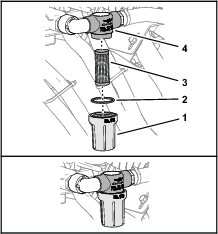
-
Allow any residual chemical solution to drain from the strainer body.
Note: Dispose of the waste solution according to local codes and the chemical manufacturer's instructions.
-
Use a soft-bristle brush and clean water to clean the screen and bowl.
-
Install the screen into the strainer body (Figure 54).
-
Install the gasket and strainer bowl onto the strainer body, and hand tighten the bowl (Figure 54).
Cleaning the Sprayer Nozzles
| Maintenance Service Interval | Maintenance Procedure |
|---|---|
| After each use |
|
-
Rotate the nozzle cap 90° counterclockwise and remove the cap from the nozzle body (Figure 55).
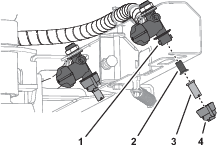
-
Remove the sprayer tip and strainer from the nozzle body (Figure 55).
Note: Replace any worn or damaged nozzle parts.
-
Use a soft-bristle brush and clean water to clean the nozzle tip and strainer.
-
Assemble the strainer into the nozzle body (Figure 55).
-
Assemble the sprayer tip into the nozzle cap (Figure 55).
-
Install the tip and cap onto the nozzle body (Figure 55).
Note: Use the slot to rotate the atomizer (Figure 56) of the sprayer tip forward (in-line with the flow-regulator case of the nozzle body).
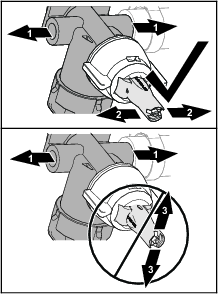
-
Rotate the nozzle cap 90° clockwise (Figure 55).
-
Repeat steps 1 through 7 for the other spray nozzles.
Transporting the Machine
Do not exceed the weight of the machine with both the sprayer tank and hopper empty or with both the sprayer tank and hopper full when towing a trailer; refer to Specifications.
Caution
This machine does not have turn signals, lights, reflective markings, or a slow moving vehicle emblem. Driving on a street or roadway without such equipment is dangerous and can lead to accidents causing personal injury.
Do not drive the machine on a public street or roadway.
Note: Refer to the chemical warning product label(s) before transporting the machine and follow all local/state/federal requirements for transporting chemicals.
Note: Make sure that the spreader hopper cover and the spray wand are secure before transporting.
Loading the Machine
Warning
Loading a machine onto a trailer or truck increases the possibility of tip-over and could cause serious injury or death.
-
Use extreme caution when operating a machine on a ramp.
-
Back the machine up the ramp and walk it forward down the ramp.
-
Avoid sudden acceleration or deceleration while driving the machine on a ramp as this could cause a loss of control or a tip-over situation.
-
Do not attempt to turn the machine while on the ramp; you may lose control and drive off the side.
-
Use only a single, full-width ramp; do not use individual ramps for each side of the machine.
-
If you must use individual ramps, use enough ramps to create an unbroken ramp surface wider than the machine.
Use a heavy-duty trailer or truck to transport the machine. Ensure that the trailer or truck has all the necessary brakes, lighting, and marking as required by law. Please carefully read all the safety instructions.
-
If using a trailer, connect it to the towing vehicle and connect the safety chains.
-
If applicable, connect the trailer brakes.
-
Lower the ramp.
-
Align the machine to the ramp and lock the caster wheels; refer to Caster-Lock Pedal
-
Back the machine up the ramp (Figure 57).

-
Secure the machine; refer to Securing the Machine for Transport.
-
If your machine has material in the spreader hopper, install the hopper cover
Securing the Machine for Transport
Warning
Securing the machine at any upper frame location could cause the parking brake to not function properly, which could cause serious injury or death.
Only use the front tie-down locations at the lower frame to secure the front of the machine.
Only use the rear tie-down locations at the back of the frame to secure the back of the machine.
Note: Refer to the chemical-warning-product label(s) before transporting the machine and follow all local/state/federal requirements for transporting chemicals.
Note: Ensure that the spreader-hopper cover and the spray wand are secure before transporting.
-
At the left side of the machine, ensure that the shutoff valve for the sprayer tank is closed and the drain plug is secure. At the right side of the machine, ensure that the pump-shutoff valve is closed.
-
Shut off the engine, remove the key, and engage the parking brake(s).
-
Block the tires.
-
Use the tie-down points on the machine to securely bind the machine to the trailer or truck with straps, chains, cable, or ropes (Figure 58 and Figure 59 or Figure 60). Refer to local regulations for trailer and tie-down requirements.
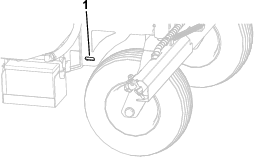
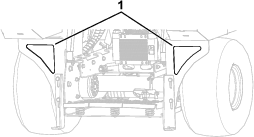
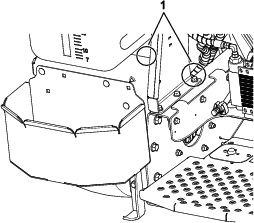
Maintenance
Maintenance Safety
-
While performing maintenance on the machine, someone could start the engine. Accidental starting of the engine could seriously injure you or others. Remove the key from the ignition switch, engage parking brake, and pull the wire(s) off the spark plug(s) before you do any maintenance. Also, push the wire(s) aside so that it does not accidentally contact the spark plug(s).
-
The engine can become very hot. Touching a hot engine can cause severe burns. Allow the engine to cool completely before servicing or repairing around the engine area.
-
Park the machine on level ground and allow it to cool. Never allow untrained personnel to service the machine.
-
Disengage the spray or close the spreader gate, set the parking brake, shut off the engine, and remove the key or disconnect the spark-plug wire. Wait for all movement to stop before adjusting, cleaning, or repairing the machine.
-
Disconnect the battery or remove the spark-plug wire before making any repairs. Disconnect the negative terminal first and the positive terminal last. Connect positive terminal first and negative terminal last.
-
Relieve the pressure from the spray system before servicing the machine.
-
Empty the tank and/or hopper before tilting the machine for maintenance and before storage.
-
Hydraulic fluid escaping under pressure can penetrate skin and cause injury. Fluid accidentally injected into the skin must be surgically removed within a few hours by a doctor familiar with this form of injury; otherwise, gangrene may result.
-
If equipped, ensure that all hydraulic fluid hoses and lines are in good condition and that all hydraulic connections and fittings are tight before applying pressure to the hydraulic system.
-
Keep your body and hands away from pinhole leaks or nozzles that eject high-pressure hydraulic fluid.
-
Use cardboard or paper, not your hands, to find hydraulic leaks.
-
Safely relieve all pressure in the hydraulic system by placing the motion-control levers in neutral and shutting off the engine before working on the hydraulic system.
-
-
Raising the machine for service or maintenance relying solely on mechanical or hydraulic jacks could be dangerous. The mechanical or hydraulic jacks may not be enough support or may malfunction, allowing the machine to fall and cause possible injury. Do not rely solely on mechanical or hydraulic jacks for support. Use adequate jack stands or equivalent support.
-
Carefully release the pressure from components with stored energy.
-
Keep your hands and feet away from moving parts. If possible, do not make adjustments while the engine is running. If the maintenance or adjustment procedure requires the engine to be running and components moving, use extreme caution.
-
Contact with moving parts or hot surfaces may cause personal injury. Keep your fingers, hands, and clothing clear of rotating components and hot surfaces.
-
Check all bolts frequently to maintain their proper tightness.
Recommended Maintenance Schedule(s)
| Maintenance Service Interval | Maintenance Procedure |
|---|---|
| After the first 5 hours |
|
| After the first 100 hours |
|
| Before each use or daily |
|
| After each use |
|
| Every 25 hours |
|
| Every 40 hours |
|
| Every 50 hours |
|
| Every 80 hours |
|
| Every 100 hours |
|
| Every 400 hours |
|
| Every 500 hours |
|
| Monthly |
|
| Yearly |
|
| Yearly or before storage |
|
Notation for Areas of Concern
| Inspection performed by: | ||
| Item | Date | Information |
| 1 | ||
| 2 | ||
| 3 | ||
| 4 | ||
| 5 | ||
| 6 | ||
| 7 | ||
| 8 | ||
Important: Refer to your engine owner’s manual for additional maintenance procedures.
Pre-Maintenance Procedures
Preparing the Machine
Warning
While you are maintaining or adjusting the machine, someone could start the engine. Accidentally starting the engine could seriously injure you or other bystanders.
Remove the key from the ignition, engage parking brake, and pull the wire(s) off the spark plug(s) before you do any maintenance. Also push the wire(s) aside so it does not accidentally contact the spark plug(s).
Perform the following before servicing, cleaning, or making any adjustments to the machine.
-
Shut the hopper-door control, shut off the impeller-speed control, shut off the boom sprayer-control valves, and shut off the sprayer-pump switch.
-
Park the machine on a level surface.
-
Move the motion controls to the NEUTRAL position.
-
Shut off the engine and remove the key.
-
Engage the parking brake.
-
Wait for all moving parts to stop allow the engine to cool before servicing, storing, or making repairs.
-
Remove the cable from the negative battery terminal (Figure 61).

Lubrication
Grease Specification
Grease type: National Lubricating Grease Institute (NGLI) grade No. 2 multi-purpose gun grease.
Greasing the Caster Pivots
| Maintenance Service Interval | Maintenance Procedure |
|---|---|
| Every 100 hours |
|
-
Prepare the machine for maintenance; refer to Preparing the Machine.
-
Wipe the grease fittings at caster clean with a rag (Figure 64).
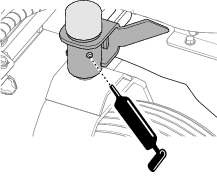
-
Connect a grease gun to the fittings (Figure 64).
-
Pump grease into the fittings until grease begins to come out of the bearings.
-
Wipe up any excess grease.
-
Repeat steps 1 through 5 at the other caster pivot.
Lubricating the Caster-Axle Bearings
| Maintenance Service Interval | Maintenance Procedure |
|---|---|
| Yearly |
|
-
Prepare the machine for maintenance; refer to Preparing the Machine.
-
Connect a grease gun to the fitting in the hub of the caster wheel (Figure 65).
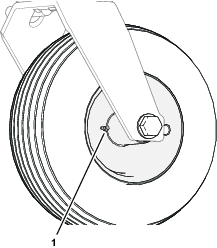
-
Pump grease into the fittings until grease begins to come out of the bearings.
-
Wipe up any excess grease.
-
Repeat steps 2 through 4 at the other caster wheel.
Greasing the Belt Tensioner
| Maintenance Service Interval | Maintenance Procedure |
|---|---|
| Every 100 hours |
|
-
Prepare the machine for maintenance; refer to Preparing the Machine.
-
At the bottom of the machine, wipe the grease fittings at belt tensioner pivot clean with a rag (Figure 66).
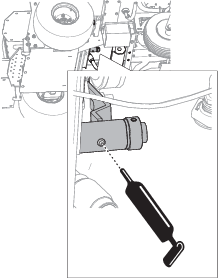
-
Connect a grease gun to the fittings (Figure 66).
-
Pump grease into the fittings until grease begins to come out of the bushings.
-
Wipe up any excess grease.
Engine Maintenance
Servicing the Air Cleaner
| Maintenance Service Interval | Maintenance Procedure |
|---|---|
| Every 25 hours |
|
| Every 400 hours |
|
Important: Do not operate the engine without the air filter assembly; extreme engine damage may occur.
Cleaning the Foam Filter Element
-
Remove the knee pad; refer to Removing the Knee Pad.
-
Remove the foam pre-cleaner from the paper element.(Figure 67).
-
Wash the pre-cleaner with warm water and a mild detergent.
-
Rinse the pre-cleaner and allow it to air dry.
-
Lightly oil pre-cleaner with new engine oil; squeeze out excess oil.
-
Install the knee pad; refer to Installing the Knee Pad.
Replacing the Air-Cleaner Assembly
-
Remove the knee pad; refer to Removing the Knee Pad.
-
Unhook the clips on the air-cleaner cover and remove the cover (Figure 67).
-
Remove the knob and plate (Figure 67).
-
Carefully remove the air-cleaner assembly to prevent debris from entering the carburetor.
-
Install the new foam pre-cleaner on to the new cartridge (Figure 67).
-
Install the air-cleaner assembly, plate, and knob in the body (Figure 67).
-
Install the cover and secure it using the clips (Figure 67).
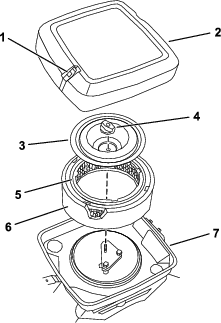
-
Install the knee pad; refer to Installing the Knee Pad.
Engine Oil Specification
Oil Type: Toro 4-Cycle Premium Engine Oil or a high-quality detergent oil (including synthetic) API service SJ or higher
Oil viscosity: Refer to the table below.
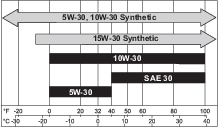
Checking the Engine-Oil Level
| Maintenance Service Interval | Maintenance Procedure |
|---|---|
| Before each use or daily |
|
Important: Do not operate the engine with the oil level below the Low (or Add) mark on the dipstick, or over the Full mark.
-
Move the machine to a level surface.
-
Prepare the machine for maintenance; refer to Preparing the Machine.
-
Remove the dipstick from the engine and wipe the dipstick with a clean rag (Figure 69).
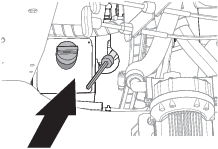
-
Insert the dipstick into the engine (Figure 70.
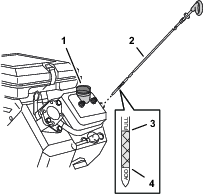
-
Remove the dipstick from the filer neck, and check oil level on the dipstick (Figure 70).
Note: The engine oil level must cover the hatch-marked area of the dipstick (Figure 70).
-
If the oil level is low, wipe off the area around the filler neck and add the specified oil (Figure 71) until the oil level is between the hatch marked areas on the dipstick.
Important: Do not overfill the engine with oil.
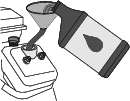
Changing the Engine Oil and Engine-Oil Filter
| Maintenance Service Interval | Maintenance Procedure |
|---|---|
| After the first 5 hours |
|
| Every 100 hours |
|
Draining the Engine Oil
-
Prepare the machine for maintenance; refer to Preparing the Machine.
-
Align the oil-drain hose out the left side of the machine, and remove the plug from the hose (Figure 72).
Note: Allow the engine oil to drain completely.
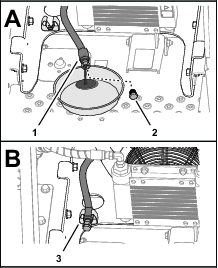
-
Install the drain plug into the hose, and tighten the plug (Figure 72).
Note: Wipe clean any residual oil.
Changing the Engine-Oil Filter
Adding Engine Oil to the Engine
Approximate engine oil capacity: 1.6 L (56 fl oz)
Important: Do not operate the engine with the oil level below the Low (or Add) mark on the dipstick, or over the Full mark.
-
Remove the dipstick from the filler neck of the engine and wipe the dipstick and filler neck with a clean rag (Figure 74).

-
Slowly pour 1.6 L (56 fl oz) of the specified oil into the filler neck (Figure 75) of the engine; refer to Engine Oil Specification.

-
Insert the dipstick into the filler neck and tighten the dipstick Figure 76.
-
Remove the dipstick from the filler neck and look at the oil level in the dipstick (Figure 76).
Note: The engine oil level must cover the hatch-marked area of the dipstick (Figure 76).

-
If the oil level is low, add the specified oil into the engine until the oil level is between the hatch marked areas on the dipstick (Figure 76).
Important: Do not overfill the engine with oil.
-
Insert the dipstick into the filler neck and hand tighten the dipstick (Figure 76).
Servicing the Spark Plug
| Maintenance Service Interval | Maintenance Procedure |
|---|---|
| Every 100 hours |
|
Spark Plug Specification
Spark plug type: Champion® RJ12
Removing the Spark Plug
-
Prepare the machine for maintenance; refer to Preparing the Machine.
-
Remove the spark plug as shown in Figure 77.

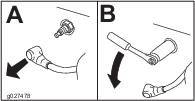
Checking the Spark Plug
Spark-plug gap: 0.76 mm (0.030 inch)
Important: Do not clean the spark plug(s). Always replace the spark plug(s) when it has a black coating, worn electrodes, an oily film, or cracks.
If you see light brown or gray on the insulator, the engine is operating properly. A black coating on the insulator usually means the air cleaner is dirty.
Use a gapping tool/feeler gauge to check and adjust the air gap to 0.76 mm (0.030 inch).
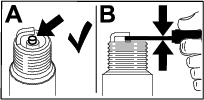
Installing the Spark Plug
Tighten the spark plug as follows:
-
New spark plug—12 to 15 N∙m (8.7 to 10.8 ft-lb)
-
In-service spark plug—23 to 27 N∙m (16.6 to 19.5 ft-lb)
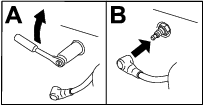
Fuel System Maintenance
Replacing the Fuel Filter
| Maintenance Service Interval | Maintenance Procedure |
|---|---|
| Every 400 hours |
|
-
Inboard of the right spray tank, squeeze the tabs on the clamps and slide the clamps away from the fuel filter (Figure 80).
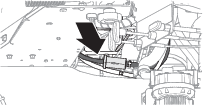
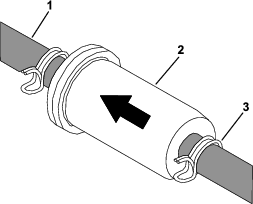
-
Rotate and pull the fuel lines off the fuel filter (Figure 80).
Check the fuel lines for cracks or leaks; repair, if necessary.
-
Replace the fuel filter (Figure 80).
Important: Align the fuel filter with the arrow pointing toward the engine fuel pump.
-
Secure the fuel lines to the filter using the clamps (Figure 80).
Electrical System Maintenance
Servicing the Battery
| Maintenance Service Interval | Maintenance Procedure |
|---|---|
| Monthly |
|
Always keep the battery clean and fully charged. Use a paper towel to clean the battery case. If the battery terminals are corroded, clean them with a solution of 4 parts water and 1 part baking soda. Apply a light coating of grease to the battery terminals to prevent corrosion.
Voltage: 12 V
Danger
Charging or jump starting the battery may produce explosive gases. Battery gases can explode causing serious injury.
-
Keep sparks, flames, or cigarettes away from battery.
-
Ventilate when charging or using battery in an enclosed space.
-
Ensure that the venting path of battery is always open once the battery is filled with acid.
-
Do not lean over the batteries.
-
Always shield eyes and face from battery.
Danger
Battery electrolyte contains sulfuric acid, which is poisonous and can cause severe burns. Swallowing electrolyte can be fatal or if it touches skin can cause severe burns.
-
Wear eye protection to shield your eyes and rubber gloves to protect your skin and clothing when handling electrolyte.
-
Do not swallow electrolyte.
-
In the event of an accident, flush with water and call a doctor immediately.
Checking the Battery Charge
Caution
If the ignition is in the ON position, there is potential for sparks and for engine components to move. Sparks could cause an explosion or moving parts could accidentally engage, causing personal injury.
Ensure that the ignition switch is in the OFF position before charging the battery.
-
Prepare the machine for maintenance; refer to Preparing the Machine.
-
Carefully slip back the insulator cover of the positive battery cable (Figure 84).
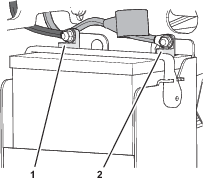
-
Measure the voltage of the battery with a voltmeter.
-
Use the table below to locate the charge state or the battery, and if needed, the battery-charger setting and charging interval recommended to charge the battery to 12.6 V or greater; refer to the battery charge table below.
Important: Ensure that the negative battery cable is disconnected, and the battery charger used for charging the battery has an output of 16 V and 7 A or less to avoid damaging the battery (see chart for recommended charger settings).
Battery Charge Table
Voltage Reading Percent Charge Maximum Charger Settings Charging Interval 12.6 or greater 100% 16 V/7 A No Charging Required 12.4 to 12.6 75 to 100% 16 V/7 A 30 Minutes 12.2 to 12.4 50 to 75% 16 V/7 A 1 Hour 12.0 to 12.2 25 to 50% 14.4 V/4 A 2 Hours 11.7 to 12.0 0 to 25% 14.4 V/4 A 3 Hours 11.7 or less 0% 14.4 V/2 A 6 Hours or More -
If the positive cable is also disconnected, connect the positive (red) cable to the positive battery terminal and slip terminal cover over the positive terminal (Figure 81).
-
Remove the screw, washer, and ground cable from the engine. Secure the battery cable to the battery terminal with the bolt, washer, and nut and torque the nut and bolt to 1978 to 2542 N∙cm (175 to 225 in-lb).
Note: If time does not permit charging the battery or if charging equipment is not available, connect the negative battery cables and run the vehicle continuously for 20 to 30 minutes to charge the battery.
-
Carefully slip back the insulator cover of the positive battery cable over the battery terminal (Figure 81).
Charging the Battery
Warning
Charging the battery produces gasses that can explode.
Never smoke near the battery and keep sparks and flames away from battery.
Important: Always keep the battery fully charged (1.265 specific gravity) to prevent battery damage when the temperature is below 32°F (0°C).
-
Remove the battery from the chassis; refer to Removing the Battery.
-
Check the electrolyte level.
-
Ensure that the filler caps are installed on the battery.
-
Charge the battery for 1 hour at 25 to 30 A or 6 hours at 4 to 6 A.
-
When the battery is fully charged, unplug the charger from the electrical outlet, and disconnect the charger leads from the battery posts (Figure 82).
-
Install the battery onto the machine and connect the battery cables; refer to Installing the Battery.
Note: Do not run the machine with the battery disconnected; electrical damage may occur.
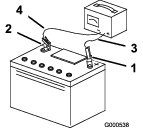
Removing and Installing the Battery
Removing the Battery
Warning
Battery terminals or metal tools could short against metal machine components, causing sparks. Sparks can cause the battery gasses to explode, resulting in personal injury.
-
When removing or installing the battery, do not allow the battery terminals to touch any metal parts of the machine.
-
Do not allow metal tools to short between the battery terminals and metal parts of the machine.
Warning
Incorrect battery-cable routing could damage the machine and cables causing sparks. Sparks can cause the battery gasses to explode, resulting in personal injury.
-
Always disconnect the negative battery cable (black) before disconnecting the positive (red) cable.
-
Always connect the positive battery cable (red) before connecting the negative (black) cable.
-
Prepare the machine for maintenance; refer to Preparing the Machine.
-
Remove the flange locknut and carriage bolt that secure the negative battery cable to the battery, and remove the cable from the battery (Figure 83).
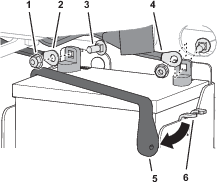
-
Slip back the insulator cover of the positive battery cable (Figure 83).
-
Remove the flange locknut and carriage bolt that secure the positive battery cable to the battery, and remove the cable from the battery (Figure 83).
-
Remove the battery strap from the flange of the battery box (Figure 83).
-
Remove the battery from the battery box of the machine.
Installing the Battery
-
Place the battery into the battery box.
-
Secure the battery to the battery box with the battery strap (Figure 83).
-
Assemble the positive battery cable to the positive terminal of the battery with the carriage bolt and flange locknut (Figure 83).
-
Slip back the insulator cover of the positive battery cable over the battery terminal.
-
Assemble the negative battery cable to the positive terminal of the battery with the carriage bolt and flange locknut (Figure 83).
Jump-Starting the Machine
Danger
Jump-starting a battery that is cracked, frozen, has low electrolyte level, or an open/shorted battery cell can cause an explosion, resulting in serious personal injury.
Do not jump-start a battery if these conditions exist; replace the battery.
Caution
Corrosion or loose connections can cause unwanted electrical voltage spikes at any time during the jump-starting procedure.
Do not attempt to jump start a machine with loose or corroded battery terminals, or damage to the engine can occur.
Caution
Connecting the jumper cables incorrectly can immediately damage the electrical system.
Be certain of the battery-terminal polarity and the jumper-cable polarity when connecting to the battery.
Important: Be sure that the vehicles do not touch and that both electrical systems are off and at the same rated system voltage. These instructions are for negative-ground systems only.
Important: Use the properly sized jumper cables (4 to 6 AWG) with short lengths to reduce the voltage drop between systems. Ensure that the cables are color coded or labeled for the correct polarity.
-
Check the battery terminals of the discharged battery and the booster battery for corrosion (white, green, or blue “snow”).
Note: Clean the corrosion from the battery terminals prior to jump starting. Tighten the battery cable connections as necessary.
-
Ensure that the booster is a 12 V battery with a sufficient amp rating that is in good condition and fully charged.
Note: Ensure that the vent caps are tight and level. If available, place a damp cloth over any vent caps on both batteries.
-
Connect the positive (+) cable clamp (red) to the positive (+) terminal of the discharged battery ().
Note: The positive battery cable is wired to the starter or solenoid.

-
Connect the other positive (+) cable clamp (red) to the positive terminal of the booster battery.
-
Connect the negative (–) cable clamp (black) to the negative terminal of the booster battery.
-
Connect the other negative (–) cable clamp (black) to the engine block of the stalled machine and away from the discharged battery.
Important: Do not connect the negative (–) cable clamp (black) to the negative battery post of the discharged battery.
-
Stand away from the discharged battery of the machine.
-
Start the machine and remove the cables in the reverse order of connection, disconnect the engine block connection first.
Servicing the Fuses
The electrical system is protected by fuses. If a fuse opens, check the component or circuit for a load or short.
| Circuit protected | Fuse size | Location |
|---|---|---|
| Main power | 10 A | Between the ignition switch and start solenoid. |
| Sprayer | 30 A | Between the start solenoid and spray-pump relay. |
| Display | 1A | Between the ignition switch and sprayer and information display. |
-
Remove the negative battery cable from the battery; refer to step 4 of Removing the Battery.
Note: Ensure that the negative battery cable does not touch the battery terminal.
-
Open the cover of the fuse holder (Figure 85 or Figure 86).
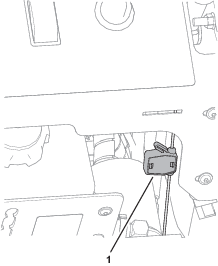
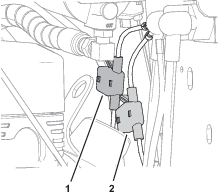
-
Pull the fuse from the socket of the fuse holder (Figure 85 or Figure 86).
-
Install a fuse of the same type into the socket of the fuse holder (Figure 85 or Figure 86).
-
Close the cover onto the fuse holder until the cover latches securely (Figure 85 or Figure 86).
-
Install the negative battery cable to the battery terminal, and install the battery cover; refer to steps 5 of Installing the Battery.
Drive System Maintenance
Checking the Tire Pressure
| Maintenance Service Interval | Maintenance Procedure |
|---|---|
| Every 50 hours |
|
Tire air pressure specification: 110 to 138 kPa (16 to 20 psi)
Important: Do not exceed the maximum air pressure indicated on the sidewall of the tire.
Note: Do not add any type of tire liner or foam fill material to the tires.

Checking the Wheel-Lug Nuts
| Maintenance Service Interval | Maintenance Procedure |
|---|---|
| Monthly |
|
Check and torque the wheel-lug nuts (Figure 88) to 129 N∙m (95 ft-lb), if needed.
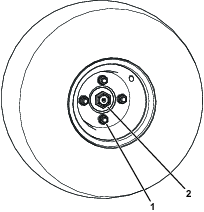
Checking the Wheel-Hub Nut
| Maintenance Service Interval | Maintenance Procedure |
|---|---|
| After the first 100 hours |
|
| Every 500 hours |
|
Check and torque the wheel-hub nut (Figure 88) to 319 N∙m (235 ft-lb), if needed.
Brake Maintenance
Adjusting the Parking Brake
-
Prepare the machine for maintenance; refer to Preparing the Machine.
-
Check the air pressure in the drive tires; refer to Checking the Tire Pressure.
-
Disengage the parking brake.
-
Loosen the 2 jam nuts on the brake linkage located at the left, rear side of the machine (Figure 89).
-
To increase the brake force, turn the linkage counterclockwise 1 to 2 turns (Figure 89).
-
Engage the parking brake and check if you need to further adjust the parking brake; repeat step 5, if needed.
-
Tighten the 2 jam nuts (Figure 89).
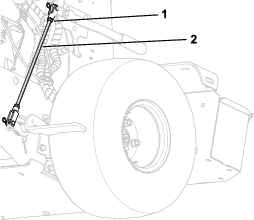
-
Check the parking brake; repeat steps 4 to 7, if needed.
Belt Maintenance
Replacing the Belt
-
Prepare the machine for maintenance; refer to Preparing the Machine.
-
Raise the machine and support it with jack stands.
-
While holding the eye bolt in place, loosen the locknut on the eye bolt to remove tension from the spring (Figure 90).
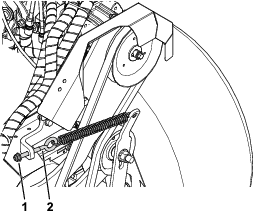
-
Pull the tension arm away from the belt and remove the existing belt from the pulleys (Figure 91).
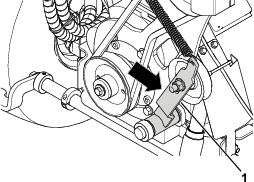
-
With the tension arm pulled away from the pulley system, route the new belt, starting at the hydraulic-motor pulley, then around the engine pulley and tensioner pulley (Figure 92).
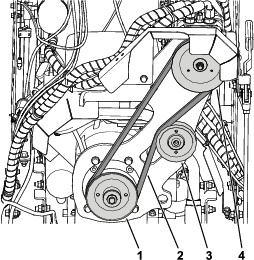
-
Tension the belt; refer to Adjusting the Belt Tension.
-
Lower the machine from the jack stands.
Adjusting the Belt Tension
-
Ensure that the tension arm and pulley move freely.
-
While holding the eye bolt from rotating, tighten the locknut until the thread length after the adjustment is 32 mm (1-1/4 inches) as shown in Figure 93.
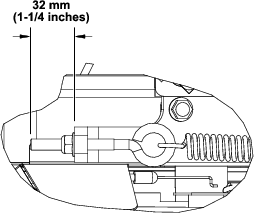
Controls System Maintenance
Adjusting the Maximum Forward Speed
-
Prepare the machine for maintenance; refer to Preparing the Machine.
-
Loosen the 2 knobs that secure the speed bar (Figure 94).
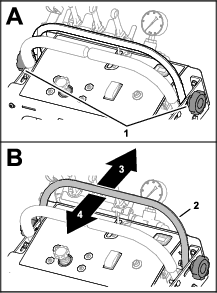
-
Adjust the position of the speed bar as follows:
-
Move the speed bar forward to increase the maximum forward speed of the machine.
-
Move the speed bar rearward to decrease the maximum forward speed of the machine.
-
-
Tighten the 2 knobs that secure the speed bar (Figure 94).
Adjusting the Motion-Control Linkage
-
Prepare the machine for maintenance; refer to Preparing the Machine.
-
Loosen the 2 knobs that secure the speed bar, and push the speed bar forward (Figure 95).
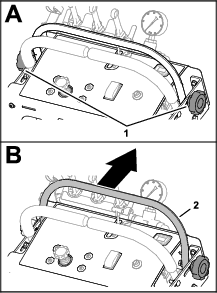
-
Push the motion-control lever forward, and measure the distance between the speed bar and motion control lever (Figure 96).
Note: The motion-control linkage is correctly adjusted when the gap between the lever and bar is 102 mm (4 inches).
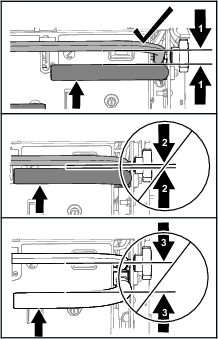
-
If the gap is larger than or smaller than 102 mm (4 inches), remove the knee pad; refer to Removing the Knee Pad.
-
Loosen the 2 jam nuts that secure the motion-control rod at the upper and lower ball joints (Figure 97).
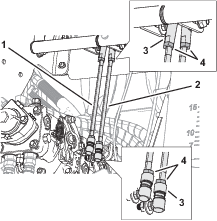
-
Adjust the motion-control rod as follows:
-
To increase the gap between the speed bar and motion control lever, rotate the motion-control rod counterclockwise.
-
To decrease the gap between the speed bar and motion control lever, rotate the motion-control rod clockwise.
-
-
Tighten the jam nuts (Figure 97).
-
Repeat steps 3 through 7 for the other motion control lever.
-
Install the knee pad; refer to Installing the Knee Pad.
Adjusting the Motion Control Tracking
If the machine travels or pulls to one side when the motion-control levers are in the full forward position, adjust the tracking.
-
While driving the machine across a flat field, push both control levers forward the same distance.
-
Check if the machine pulls to one side, stop the machine, shut off the engine, and engage the parking brake .
-
Loosen the 2 jam nuts that secure the motion-control rod at the upper and lower ball joints (Figure 98).

-
Adjust the motion-control rod as follows:
-
To increase the speed for the drive, rotate the motion-control rod counterclockwise in 1/4 turn.
-
To decrease the speed for the drive, rotate the motion-control rod clockwise in 1/4 turn.
-
-
Tighten the jam nuts (Figure 98).
-
Repeat steps 1 through 5 until the machine tracks straight when the motion-control levers are in the full forward position.
Hydraulic System Maintenance
Hydraulic Fluid Specification
Preferred fluid: Toro Hypr-Oil 500
Optional fluid: 15W-50 API rating CI-4/CF hydraulic fluid
Checking the Hydraulic Fluid Level
| Maintenance Service Interval | Maintenance Procedure |
|---|---|
| Before each use or daily |
|
Checking the Hydraulic Fluid Level
-
Prepare the machine for maintenance; refer to Preparing the Machine.
-
Remove the knee pad; refer to Removing the Knee Pad.
-
Check the hydraulic fluid level in the tank (Figure 99).
Important: When the hydraulic fluid level is correct, it is between the full and add marks on the fluid-level window of the tank mount.
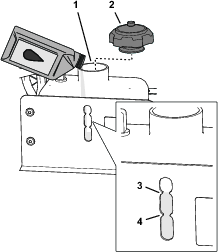
-
If the hydraulic fluid level is low, perform the following:
-
Remove the cap (Figure 99).
-
Add the specified hydraulic fluid until it is level with the full mark of the fluid-level window (Figure 99); refer to Hydraulic Fluid Specification.
-
Install the cap (Figure 99).
-
-
Install the knee pad; refer to Installing the Knee Pad.
Changing the Hydraulic Fluid and Filter
| Maintenance Service Interval | Maintenance Procedure |
|---|---|
| After the first 100 hours |
|
| Every 500 hours |
|
Hydraulic fluid quantity: 2.4 L (2.5 US qt)
-
Prepare the machine for maintenance; refer to Preparing the Machine.
-
Remove the knee pad; refer to Removing the Knee Pad.
-
Clean area around hydraulic filter and filter head (Figure 100).
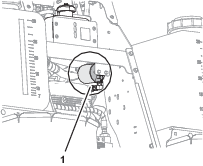
-
Align a drain pan with a 3 L (3 US qt) or greater, under the filter (Figure 101).
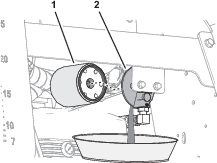
-
Remove the filter, and allow the hydraulic fluid to drain (Figure 101).
-
Apply a thin coat of the specified hydraulic fluid to the gasket of the new hydraulic filter; refer to Hydraulic Fluid Specification.
-
Thread the filter onto the filter head until the gasket contacts the filter head, and tighten the filter an additional 2/3 to 3/4 turn.
-
Add the specified hydraulic fluid to the tank; refer to step 4 in Checking the Hydraulic Fluid Level.
-
Purge the air from the hydraulic system; refer to Purging Air from the Hydraulic System.
Purging Air from the Hydraulic System
Note: You must purge air from the hydraulic system when you remove any hydraulic components, including oil filter, or disconnect any hydraulic lines.
-
Open the drive release valves at each hydraulic pump (Figure 102).
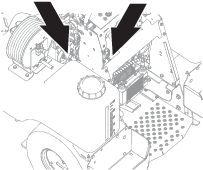
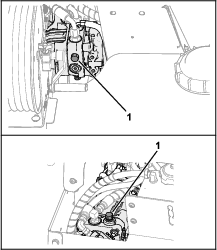
-
Raise the back of the machine until both drive wheels are off the ground, and support the machine with jack stands.
-
Start engine and move throttle control ahead to full throttle position.
-
Move the traction-control levers to the FORWARD and REVERSE positions several times position.
-
Move the traction-control levers to the NEUTRAL position, and shut off the engine.
-
Lower the machine and remove the jack stands.
-
Close the drive release valves at each hydraulic pump (Figure 102).
-
Check the hydraulic fluid level, start the engine, and run it at full throttle for several minutes, refer to Checking the Hydraulic Fluid Level.
-
Shut off the engine, and Install the knee pad refer to Installing the Knee Pad.
Checking the Hydraulic System Fittings
| Maintenance Service Interval | Maintenance Procedure |
|---|---|
| Every 40 hours |
|
Check the hydraulic hoses and fittings for leaks, damage, or wear. Repair any leaking, damaged, or worn hydraulic components.
Maintaining the Chassis
Checking the Machine for Loose Hardware
| Maintenance Service Interval | Maintenance Procedure |
|---|---|
| Before each use or daily |
|
-
Prepare the machine for maintenance; refer to Preparing the Machine.
-
Visually inspect machine for damaged or worn parts, and check for loose hardware.
Note: Before operating the machine, replace any damaged parts and tighten all loose hardware.
Maintaining the Sprayer and Spreader Systems
Checking the Sprayer System
| Maintenance Service Interval | Maintenance Procedure |
|---|---|
| Every 50 hours |
|
-
Prepare the machine for maintenance; refer to Preparing the Machine.
-
Check all hoses, nozzles, and fittings for damage and leaks.
Note: Replace all damaged or leaking sprayer components.
-
Check the nozzle strainers and in-line strainers for accumulation of dirt and chemical sludge.
Note: Clean or replace strainers with an accumulation of dirt and chemical sludge.
Checking the Spreader System
| Maintenance Service Interval | Maintenance Procedure |
|---|---|
| Every 50 hours |
|
-
Prepare the machine for maintenance; refer to Preparing the Machine.
-
Spray the hopper cables, accuway cable, and the deflector-shield cable with silicone spray, if needed.
-
Clean the bottom of the hopper with a wire brush and clean off any fertilizer, if needed.
-
Replace the hopper bottom bushing or the impeller, if needed.
Cleaning
Cleaning the Engine and the Exhaust System Area
| Maintenance Service Interval | Maintenance Procedure |
|---|---|
| After each use |
|
Caution
Excessive debris around engine-air intake and exhaust system area can cause engine, exhaust area, and hydraulic system to overheat which can create a fire hazard.
Clean all debris from engine and exhaust system area.
-
Prepare the machine for maintenance; refer to Preparing the Machine.
-
Clean all debris from the engine, around engine shrouding, fuel tank, and exhaust system area.
-
Wipe up any excessive grease or oil around the engine and exhaust system area.
-
Clean muffler-heat shields of all debris, dirt, and oil.
Cleaning the Debris from the Machine
| Maintenance Service Interval | Maintenance Procedure |
|---|---|
| After each use |
|
-
Prepare the machine for maintenance; refer to Preparing the Machine.
-
Clean off any debris or chemical build-up on the machine, especially the nozzles, sprayer-tank opening, impeller, and the spray wand and its holder.
Cleaning the Engine Debris Guard and Hydraulic-Oil Cooler
| Maintenance Service Interval | Maintenance Procedure |
|---|---|
| Every 80 hours |
|
-
Remove the 2 flange locknuts that secure the hydraulic-oil cooler to the machine, and lift the cooler (Figure 103).
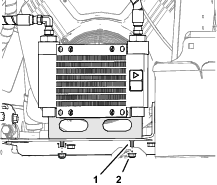
-
Use a brush or dry cloth to remove debris from the engine debris guard and the hydraulic-oil cooler (Figure 104).
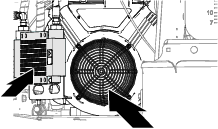
-
Assemble the hydraulic-oil cooler to the machine with the 2 carriage bolts and 2 flange locknuts (Figure 103).
Waste Disposal
Chemical Disposal
Improper chemical disposal can pollute the environment and cause health issues.
Follow the disposal directions on the chemical-manufacturer’s label. Dispose of chemicals and containers in accordance to local/state/federal laws.
Disposing of the Engine Oil
Engine oil and hydraulic fluid are both pollutants to the environment. Dispose of used pollutants at a certified-recycling center or according to your state and local regulations.
Disposing of the Battery
Danger
Battery electrolyte contains sulfuric acid, which is poisonous and can cause severe burns. Swallowing electrolyte can be fatal or if it touches skin can cause severe burns.
-
Wear eye protection to shield eyes, and rubber gloves to protect skin and clothing when handling electrolyte.
-
Do not swallow electrolyte.
-
In the event of an accident, flush with water and call a doctor immediately.
Federal law states that batteries should not be placed in the garbage. Management and disposal practices for batteries must follow relevant federal, state, or local laws.
Take the battery to a local certified-recycling center if you replace a worn or damaged battery or if the machine no longer operates and is being scrapped.
Note: If no local recycling is available, return the battery to any certified battery seller.
Storage
Short-Term Storage
-
Set sprayer-pump switch to the OFF position, stop the machine, move motion-control lever to the NEUTRAL position, shut off the engine, wait for all moving parts to stop, remove key, and engage parking brake.
-
Remove dirt and grime from the entire machine.
Important: Do not use brackish or reclaimed water to clean the machine.
Important: You can wash the machine with mild detergent and water. Do not pressure wash the machine. Avoid excessive use of water, especially near the engine and hydrostatic drive.
-
Service the air cleaner; refer to Servicing the Air Cleaner.
-
Lubricate the machine; refer to Lubrication.
-
Change the engine oil filter and oil; refer to Changing the Engine Oil and Engine-Oil Filter.
-
Check and tighten all bolts, nuts, and screws. Repair or replace any part that is damaged.
-
Paint all scratched or bare metal surfaces. Paint is available from your Authorized Service Dealer.
-
Store the machine in a clean, dry garage or storage area.
-
Cover the machine to protect it and keep it clean.
Preparing the Machine for Extended or Winter Storage
To help protect the pumps from freezing temperatures, ensure that the machine is free of all caustic chemicals and residue.
Cleaning the Spreader
Perform all the steps in Cleaning and Lubricating the Spreader.
Winterizing the Sprayer
Emptying the Tank
-
Perform all the steps in Cleaning the Sprayer System and Wand, Cleaning the Strainer, and Cleaning the Sprayer Nozzles.
-
Empty the sprayer system by performing the following:
-
Empty the sprayer tank.
-
Start the machine and set sprayer-pump switch to the ON position
-
Move the 3 boom spray-control valves to the ON position.
Note: Run the sprayer pump until the spray nozzles is spray air.
-
-
Shut off the sprayer pump and the engine.
Preparing the Sprayer System
Antifreeze type: 15 L (4 US gallon) rust inhibiting, non-alcohol based, RV-antifreeze concentrate
Important: Do not allow all the antifreeze mixture to empty from the sprayer tank while running the sprayer nozzles and wand. Keeping some of the antifreeze in the pump, valves, and hoses will help prevent corrosion and damage caused by moist air trapped in the sprayer system.Do not use brackish or reclaimed water in the spray system.
-
Pour 7.5 L (2 US gallon) RV anti-freeze concentrate into each sprayer tank.
Note: Use a rust inhibiting, non-alcohol based, RV antifreeze concentrate.
-
Open the tank shutoff valves for both spray tanks; refer to Selecting Both Spray Tanks.
-
Open the throttle valve; refer to Adjusting the Sprayer Pressure.
-
Start the machine and set the sprayer-pump switch to the ON position.
-
Move the spray-control valves to the ON position.
Note: Allow the antifreeze to circulate through sprayer and nozzle.
-
Remove the wand from its holder, point it in a safe direction, and squeeze the spray-wand trigger.
Note: Allow the antifreeze to circulate through sprayer and nozzle and then return the wand to its holder.
-
Set the sprayer-pump switch to the OFF position and shut off the engine.
Battery Storage
Disconnect the battery and place it on a trickle charger for a few hours, once per month.
Troubleshooting
Important: Ensure that the operator safety mechanisms for the machine are connected and in proper operating condition before you use the machine.
When a problem occurs, do not overlook the simple causes. For example, starting problems could be caused by an empty fuel tank.
The following table lists some of the common causes of trouble. Do not attempt to service or replace major engine items or any items that call for special timing of adjustments procedures (such as valves, governor, etc.). Have this work done by your engine service dealer.
Note: When disconnecting electrical connectors, do not pull on the wires to separate the connectors.
The Charging System
The regulated alternator system provides AC current through two output leads to the regulator-rectifier (Figure 105). The regulator-rectifier converts the AC current to DC, and regulates current to the battery. The charging rate will vary with engine RPM and temperature.
Note: Stator, regulator/rectifier, and fly-wheel are not interchangeable with other charging systems.
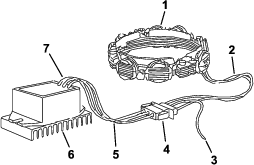
Testing the Alternator
Important: When checking the alternator components, preform the tests in the following sequence:
Testing Alternator Output
Caution
Attach meter test leads to the AC output terminals (the yellow wires) in the connector before starting the engine. If the stator is grounded (damaged or worn) and the meter test leads contact the center DC output pin (the red wire) in the connector, arcing could occur, damaging the wiring.
When checking the alternator components, preform the tests in the following sequence:
-
Disconnect stator wire harness from regulator/rectifier.
-
Insert red test lead into VΩ receptacle in meter.
-
Insert black test lead into COM receptacle.
-
Rotate selector to V~ (AC volts) position.
-
Attach red and black test lead probes to the 2 AC output terminals (yellow wires) of the connector as shown in Figure 106.
Note: You can attach the test lead probes to either AC output terminal.

-
If no or low output is found, check for bare wires or other damage.
Note: If shorted leads are not visible, replace the stator.
Note: With the engine running at 3600 rpm, the alternator should output 16 V or more.
-
Connect stator wire harness to regulator/rectifier.
Testing the DC Output Charging Wire
Use this test to check the DC output charging wire circuit. If a wiring problem exists, you can correct it before testing regulator/rectifier.
Leave stator wire harness disconnected from regulator-rectifier. Ignition switch must be in OFF position.
-
Turn the ignition switch to the OFF position.
-
Disconnect stator wire harness from regulator/rectifier.
-
Insert red test lead into VΩ receptacle in meter.
-
Insert black test lead into COM receptacle.
-
Rotate selector to V~ (AC volts) position.
-
Attach red test lead probe to the red DC output terminal of the connector (Figure 106).
-
Attach black test lead probe to negative battery terminal.
-
Turn ignition switch to the ON position.
Note: Meter should display battery voltage.
Note: Regulator-Rectifier Test
Testing the Regulator/Rectifier
You must install a DC shunt on the negative (-) terminal of the battery to avoid overloading the fuse in the meter when testing the alternator output. Ensure that all electrical connections are clean and tight for accurate amperage readings.
-
Connect stator wire harness to regulator/rectifier.
-
Install a DC shunt onto the negative battery terminal.
-
Insert red test lead into VΩ receptacle of the meter. Connect the other end of the red test lead to the post terminal of the shunt Figure 107.
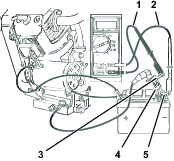
-
Insert black test lead in COM receptacle of the meter. Connect the other end of the black test lead to the black post terminal of the shunt.
-
Rotate selector of the meter to 300 mV position.
-
With the engine running at 3600 RPM, the alternator should output 3-20 A.
Note: Depending on battery voltage and/or current draw on system.
Note: If you find no or low alternator output , check that the regulator/rectifier is properly grounded, and that all electrical connections are clean and secure.If there is still no or low alternator output, replace the regulator/rectifier.
| Problem | Possible Cause | Corrective Action |
|---|---|---|
| The starter does not rotate the engine. |
|
|
| The engine does not start, it starts hard, or it fails to keep running. |
|
|
| The engine loses power. |
|
|
| The engine overheats. |
|
|
| The machine pulls to the left or the right (with steering control fully forward). |
|
|
| The machine does not drive. |
|
|
| The machine vibrates abnormally. |
|
|
| Problem | Possible Cause | Corrective Action |
|---|---|---|
| The spreader or sprayer pattern is uneven. |
|
|
| The impeller does not rotate. |
|
|
| No material dispensed from hopper. |
|
|
| There is no spray from the sprayer nozzles in the boom or the nozzles have poor output. |
|
|
| The spray wand does not work. |
|
|
Schematics
Machine Models 34233 and 34235; Electrical Schematic 135-6146
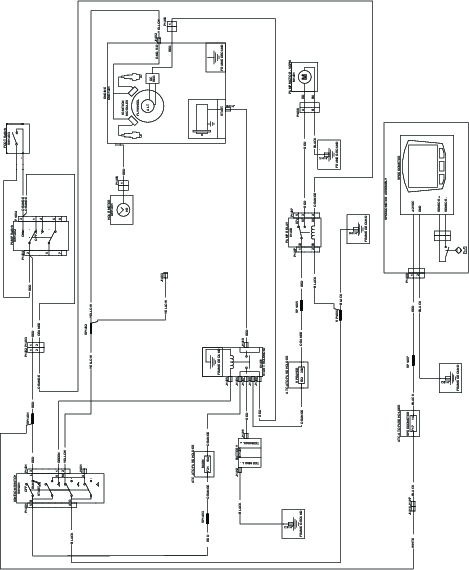
Machine Model 34237; Electrical Schematic 135-6146
